
Final report July 2025


Final report July 2025
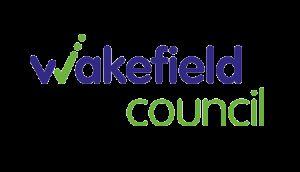
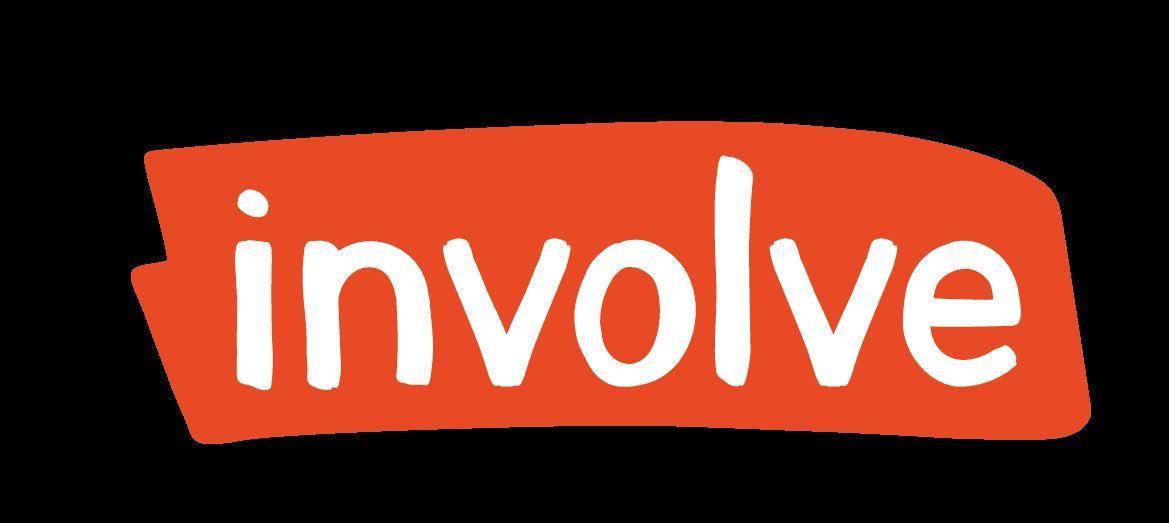
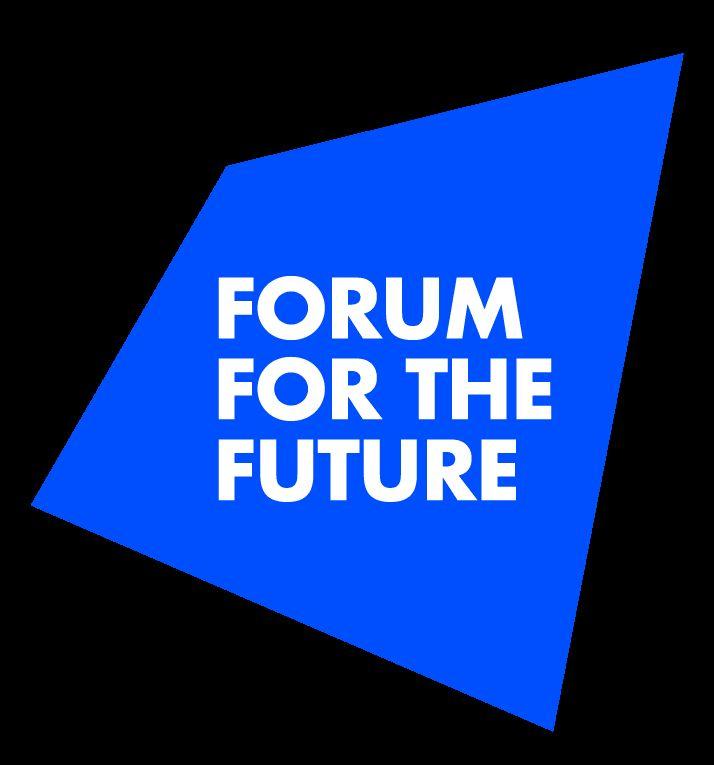
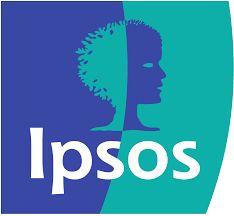



With thanks to the 20 citizen visioning members who gave their time, energy and creativity to the Building a Greener Tomorrow project.
With thanks to the inspiring speakers and dedicated Advisory Group members who helped shape the journey.
With thanks to Buttercrumble, whose brilliant graphic facilitation brought ideas to life and added energy to the process.
And finally, with thanks to the Wakefield Climate Team, our partners in designing and delivering this ambitious, collaborative project.
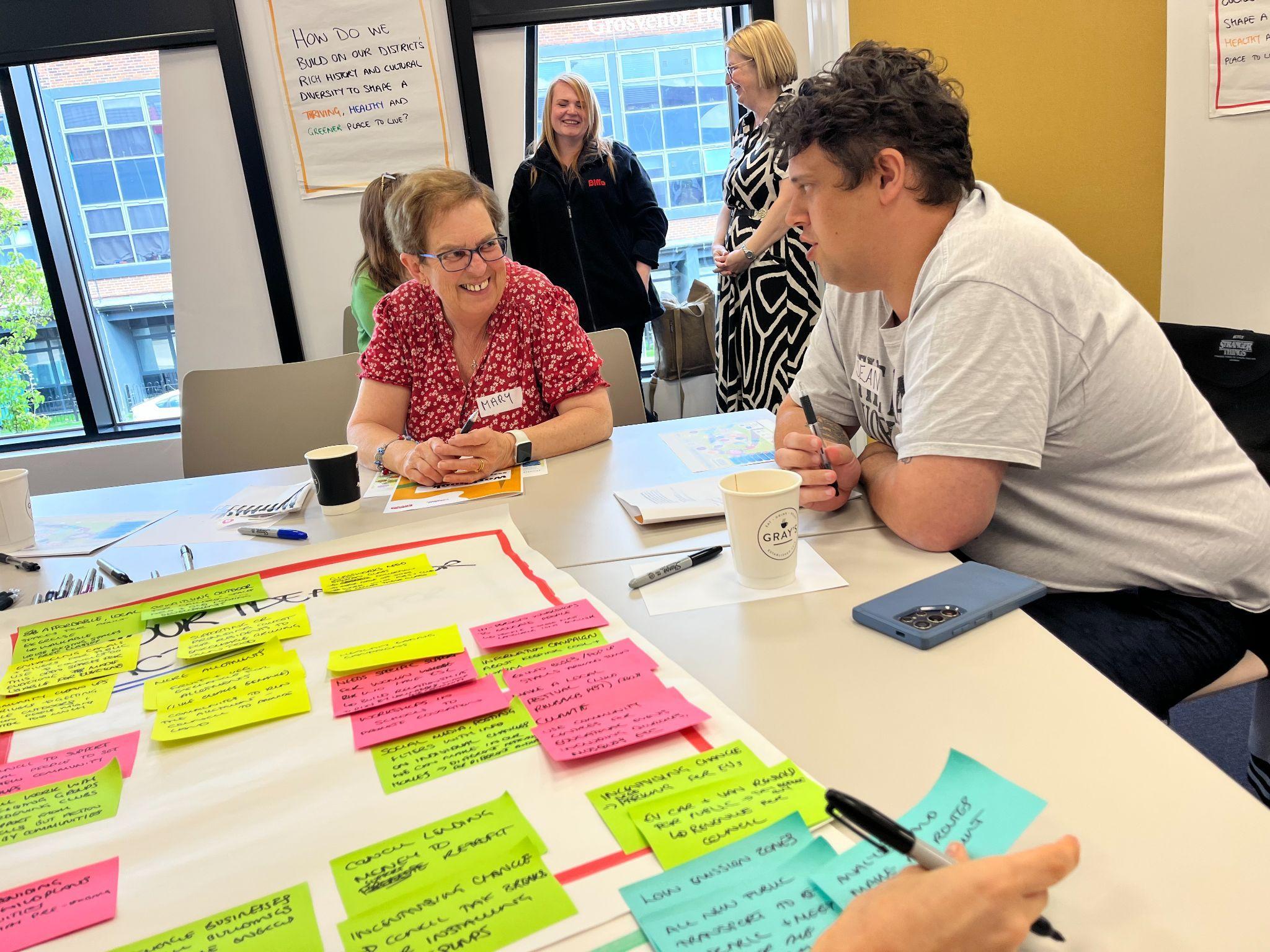



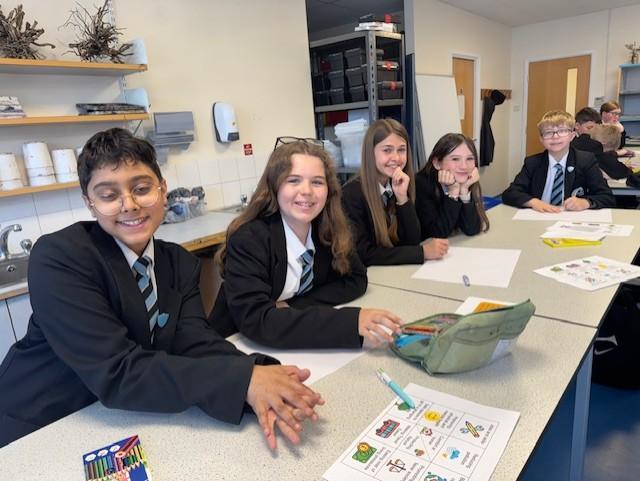


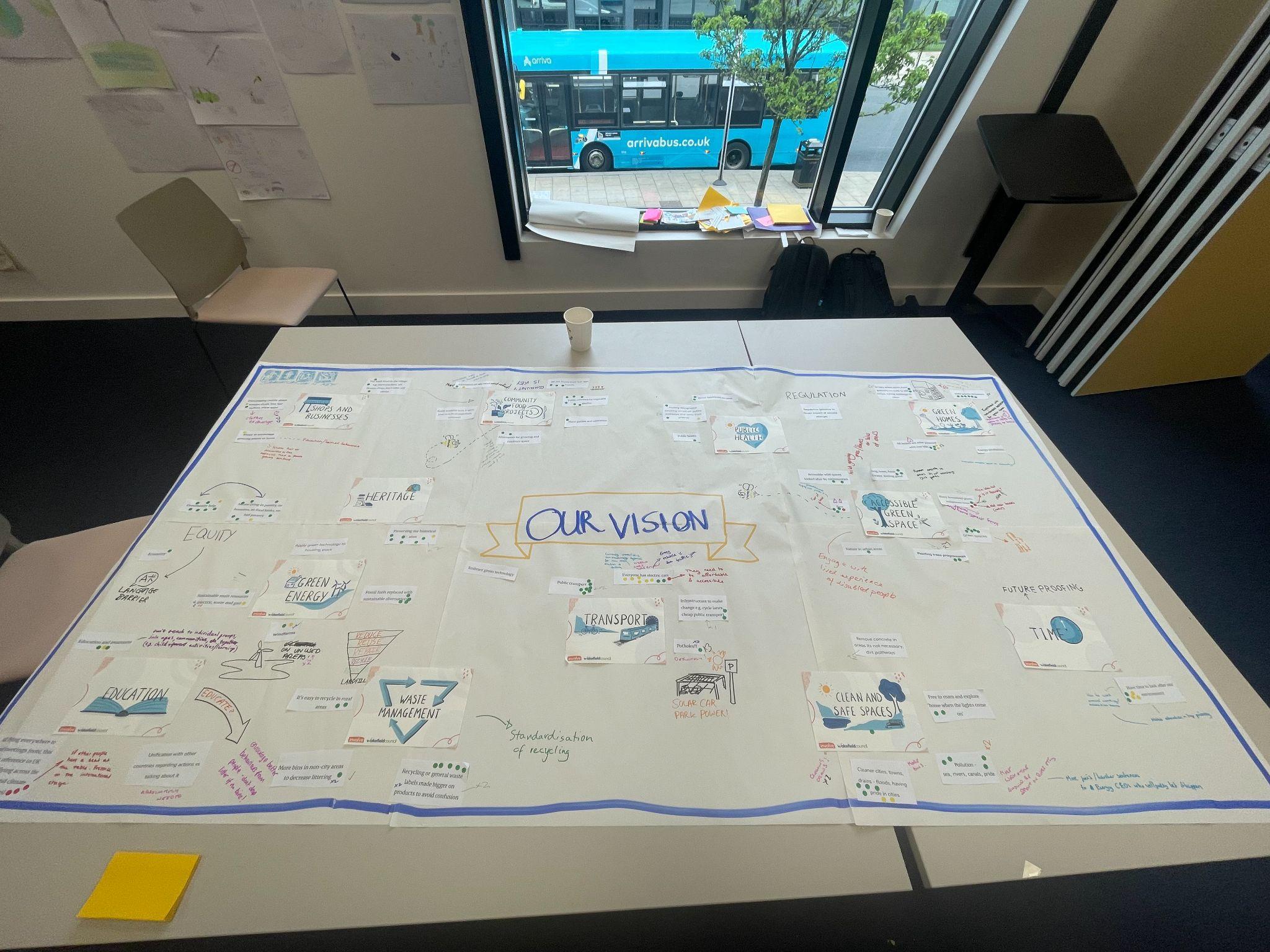






In May 2019, Wakefield Council declared a climate emergency, setting ambitious targets: to achieve carbon neutrality for council operations by 2030 and district-wide net zero emissions by 2038. Recognising that lasting climate solutions must include the people they impact most, the council committed to a community-led approach; placing residents at the heart of decision-making.
As part of Innovate UK’s Net Zero Living programme, the council worked with Involve (who wrote this report), Forum for the Future, Ipsos, and Quantum to run a citizen visioning project on how to become a net zero district. The aim was to put citizen ambitions for the future of their area at the heart of the council’s climate strategy.
Over three in-person sessions, 20 residents - reflective of the district’s diversity - came together to explore challenges, engage with speakers, and co-create local climate solutions. To amplify youth perspectives, workshops were also held with pupils from three local schools, whose creative visions informed the process.
The process was supported by a graphic facilitation team who illustrated the outputs of the discussions to support multiple learning styles.
Over the course of the three sessions, the members crafted:
● A shared vision for a thriving, healthy, and greener district
● A set of project ideas to help achieve this vision
This report captures those ideas in members’ own words.
In response, Wakefield Council has committed to:
● Share the group’s ideas at the Net Zero Summit in June 2025
● Present the report to the Advisory Group
● Share the outcomes with the participating schools
● Publish the report on the council website and distribute it to wider actors
● Use the ideas to inform the Climate Change Action Plan and District Plan
● Provide a formal response to each project idea, including explanations for any that cannot be pursued and where possible, suggesting alternative approaches
This project demonstrates the council’s commitment to inclusive, community-driven climate action - rooted in lived experiences and local pride, and focused on creating a thriving, healthier and greener future for all.
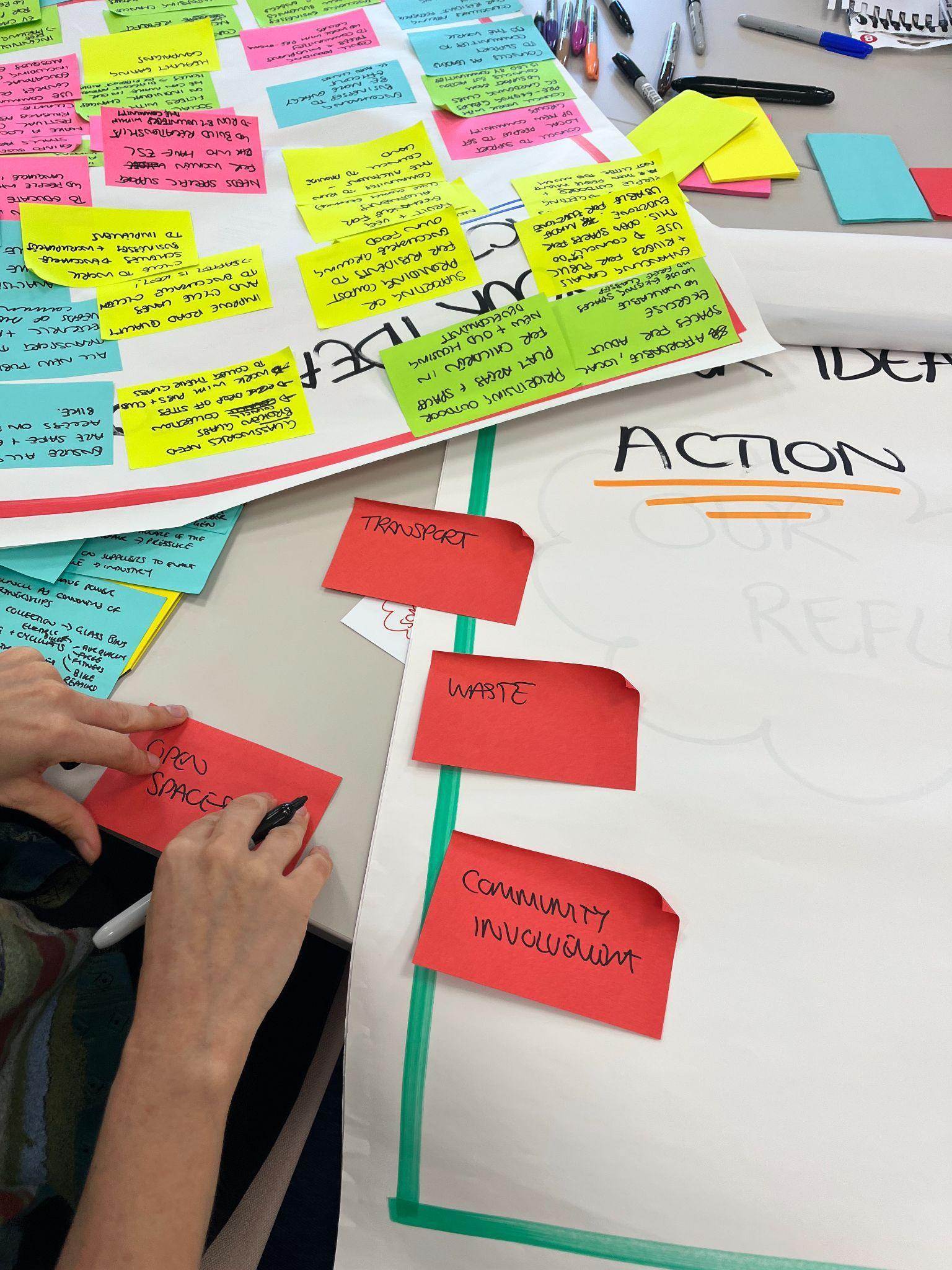
Sustainability goes beyond cutting emissions - it’s about building thriving, inclusive communities. Real climate action tackles root causes, unlocks co-benefits, and ensures everyone, especially those furthest from power, are part of the solution.
Wakefield’s proud coal mining heritage helped power the nation, shaping the district’s identity and fostering strong community values. Today, the district has the opportunity to lead the way in creating net zero solutions, honoring its past whilst building a greener, more sustainable future for all.
This project came at a good time to influence the council’s climate strategy as it aligns with the new District Plan and updated Climate Change Action Plan.
Real climate action starts with real people. Citizen visioning puts local voices at the heart of the conversation, reflecting local knowledge, lives and places. It meets people where they are, acknowledging barriers to climate action, tapping into community strengths and making space for future-focused thinking.
Members explored the bigger picture, engaging with messy systems. They used this and their own knowledge and experiences to imagine a climate-positive future for the district and practical project ideas to help make that vision a reality.
The members responded to the question: ‘How do we build on our district’s rich history and cultural diversity to shape a thriving, healthy and greener place to live?’
The members worked together, deliberated and agreed upon:

● a vision for thriving, healthy and greener place to live
● a set of projects to help us get there


Thequestion:
“How
do we build on our district’s rich history and cultural diversity to shape a thriving, healthy and greener place to live?”


Members learned about the topic from a range of speakers. Topics covered an introduction to climate change, how to think in systems, understanding the co-benefits of climate action and ideas for climate action.
Members discussed the information they had heard alongside their own ideas and experiences. They then developed initial ideas for a vision and a long list of ideas for action. The independent Advisory Group reviewed these vision ideas and ideas for action and offered written feedback.
Participants worked together to review feedback from the Advisory Group and agree on:
● A final vision
● A set of projects for how to work towards the vision

The Citizen Visioning group came together for three full-day sessions in May and June 2025. All discussions were supported by a graphic facilitation team who documented the outputs of each session.
Day One kicked off with an introduction to the project - what it is, why it is happening now, and how their ideas will feed into Wakefield’s climate strategy.
The members set the tone for collaboration, agreeing together how they’d like to work together and support each other when they ‘get it wrong’.
They heard an accessible overview of climate change, net zero, and the council’s current approach to climate action.
Then, inspired by the powerful climate-positive visions from local children and young people, members began crafting their own vision of a thriving, healthy and greener district.
Day Two focused on deepening understanding and sparking ideas for action.
Members spent time with six speakers discussing a range of topics including: thinking in systems, co-benefits of climate action, climate action across the UK, community-led climate action, the Carbon Emissions Reduction Pathway (CERP) and waste management.
Inspired by these discussions, members developed a long list of ‘ideas for action’ to help shape a thriving, healthy and greener district. They also explored the roles different actors - residents, the council, businesses, and landowners - can take in driving change together.
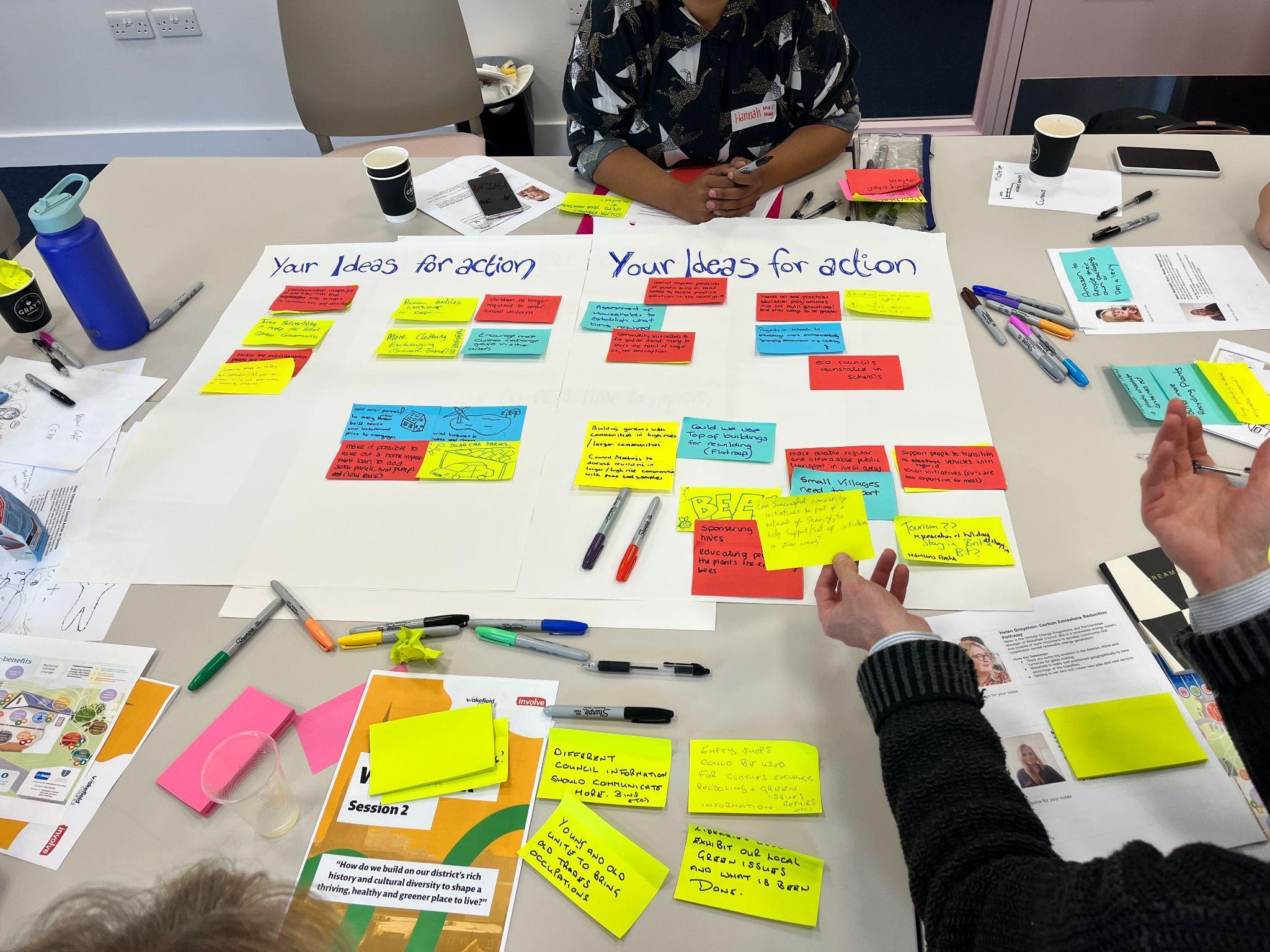
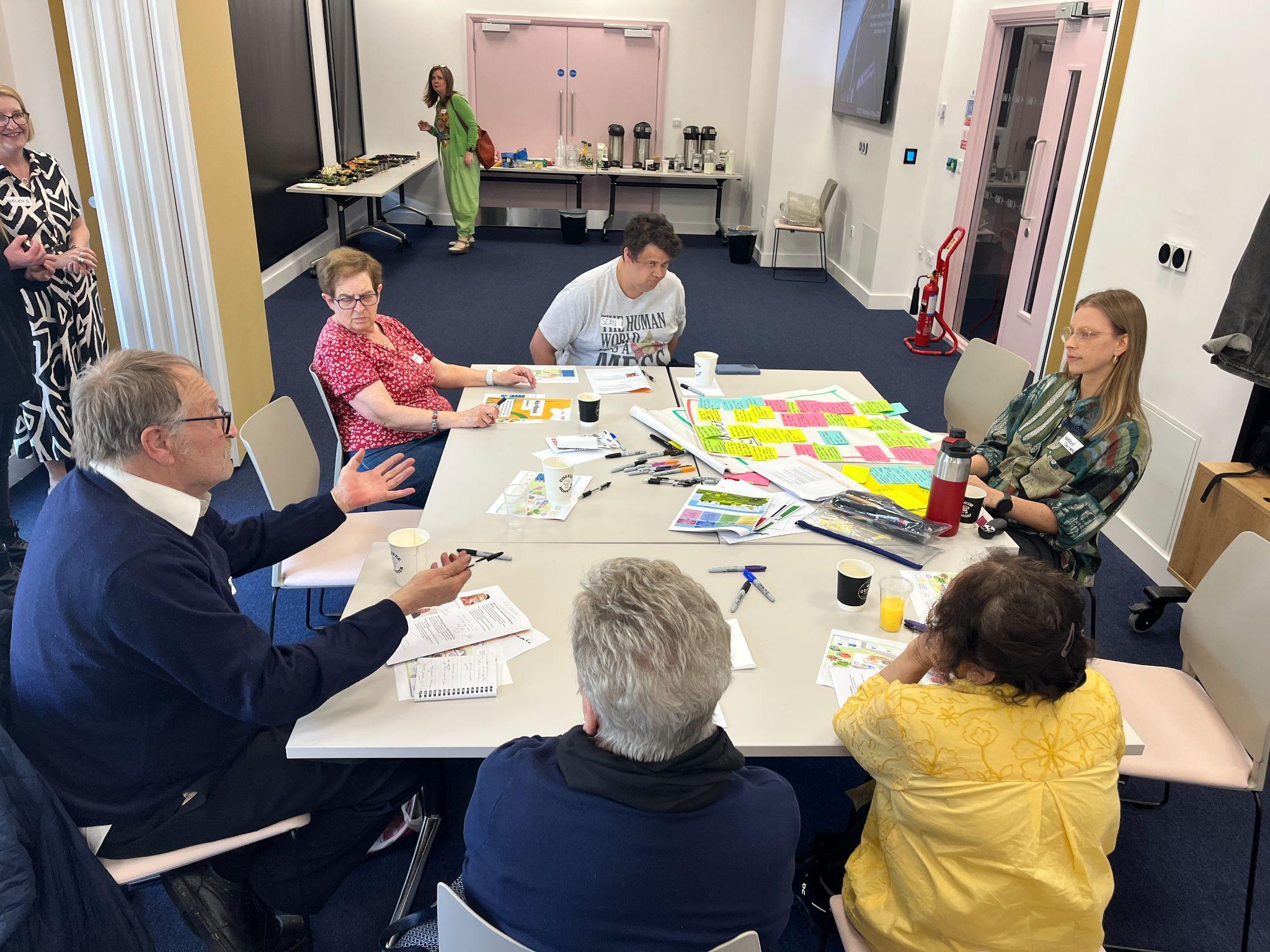
.
Day Three began with a recap of the journey so far and an update on the Advisory Group meeting that took place between sessions 2 and 3. The focus of the day was clear: shape a final vision and turn ideas for action into tangible projects.
Members revisited their ideas for action, refining them into a set of project proposals. This collaborative process included table discussions, a feedback carousel, and a full-group session to agree on the final set of projects.
A ‘silent conversation’ helped members dive deeper into their vision for the district. A small group then crafted this into a clear, compelling final vision statement.
The session closed with members presenting their vision and project ideas to council officers and councillors who shared their initial reflections. This marked a powerful moment of connection between community voices and local decision makers.
Thankyoutoourspeakers:
● Paul Hayes, Senior Policy Fellow, Leeds University
● Emma Smith and Anna Brook, Public Health Team
Wakefield Council
● Vikki Garner, Climate Reduction Manager, Wakefield Council
● Sarah Cutts, Sustainability Advocate, Take the Jump and Wakefield Clothes Exchange
● Helen Grayshan, Climate Change Programme and Partnership Manager, Wakefield Council
● Moira Mattingley-Nunn, Education Manager, Biffa

Alongside Citizen Visioning sessions, we ran three interactive workshops with children and young people across the district. Each session lasted between one and two hours and was carefully designed to ensure the voices of young people were heard and included in shaping the district’s future.
By involving younger generations, we introduced valuable intergenerational perspectives and grounded our forward-looking vision in the lives of young people across the district.
To hear from a broad range of views, we visited three schools in the district: Minsthorpe Community College, Carleton High School, and Crofton Academy.
During the sessions, students reflected on what they love about their local area, explored the co-benefits of taking climate action, and collaborated to create posters illustrating their vision for a climate-positive future.
We then showcased these posters in an exhibition for the Citizen Visioning group. This creative display helped inform and inspire the group as they developed their final vision statement for the district.

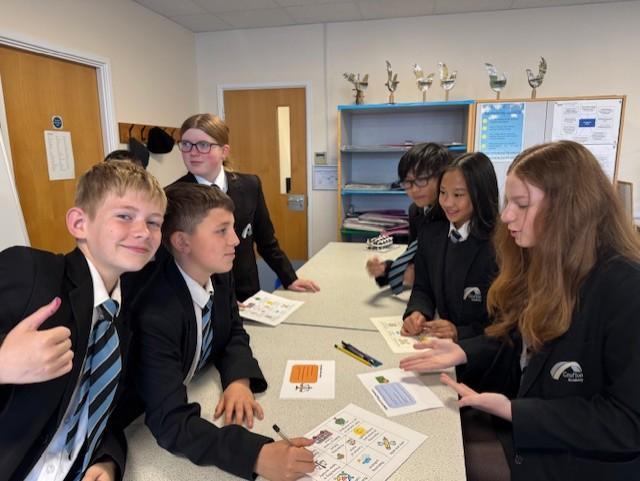
In total, 20 people were recruited to broadly reflect the population of the district.
We sent letters to 6,600 randomly selected residential addresses across the whole district. We selected members from those who’d received a letter and signed up to participate.

We gave members a ‘gift of thanks’ for taking part in all sessions, to remove financial barriers to participation and in recognition of their time. We also covered travel and any additional costs such as childcare, to help make the process more inclusive to a wide range of people.
Howwereparticipantsselected?
Our partners the Sortition Foundation selected forum members were selected using a type of civic lottery called Sortition.
Residents completed a form to express their interest in taking part. From there, we removed personal details and selected a group using a computer program to be broadly reflective of the area in in terms of their: ● Age
Gender
Disability
Ethnicity
Housing tenure
● Which area of the district they live in
● Views on Climate Change

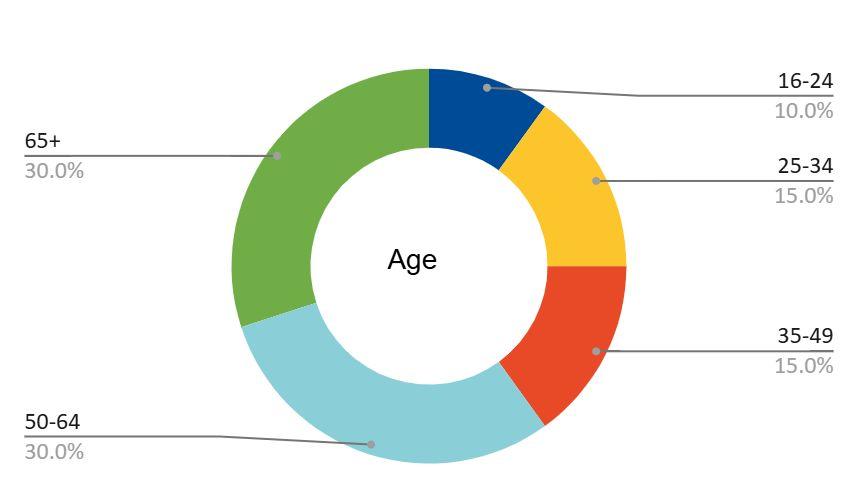
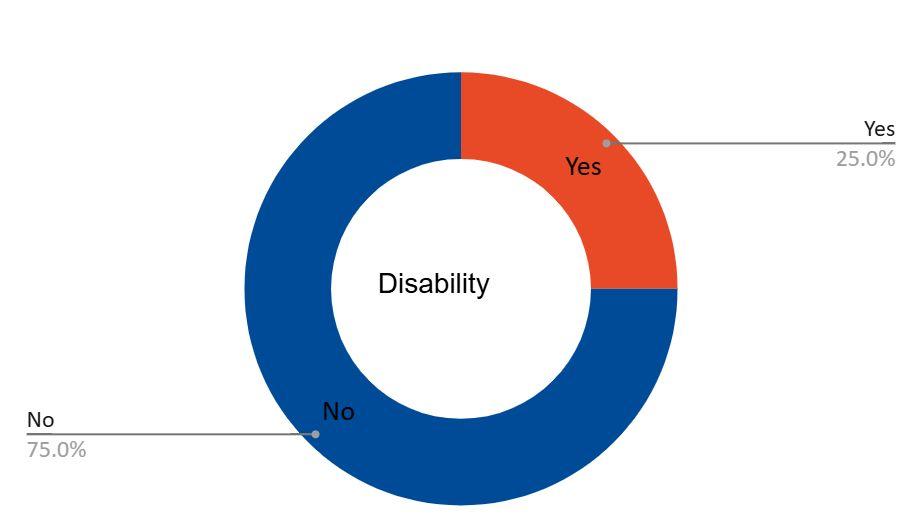
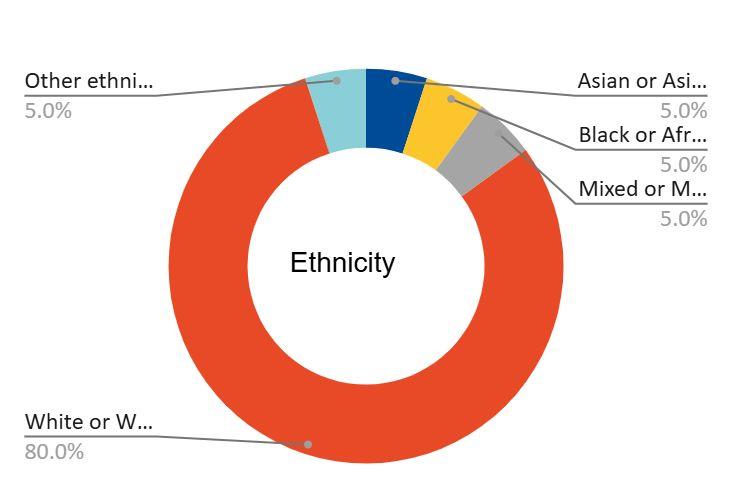
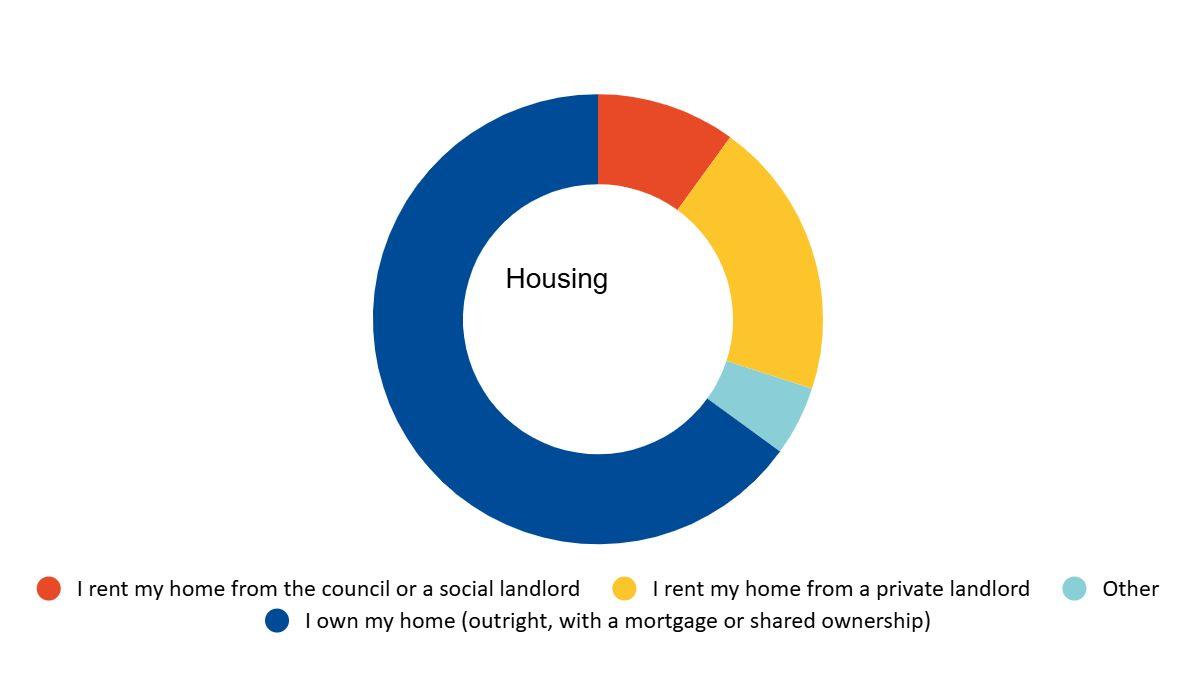
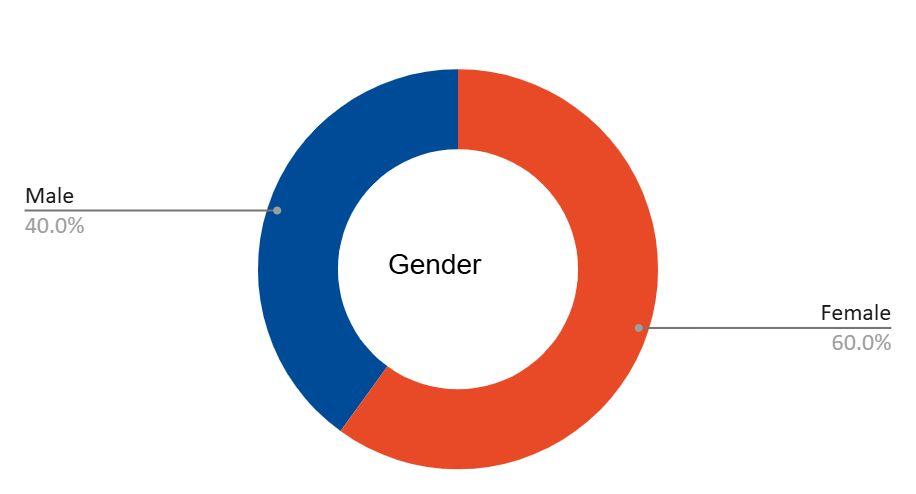
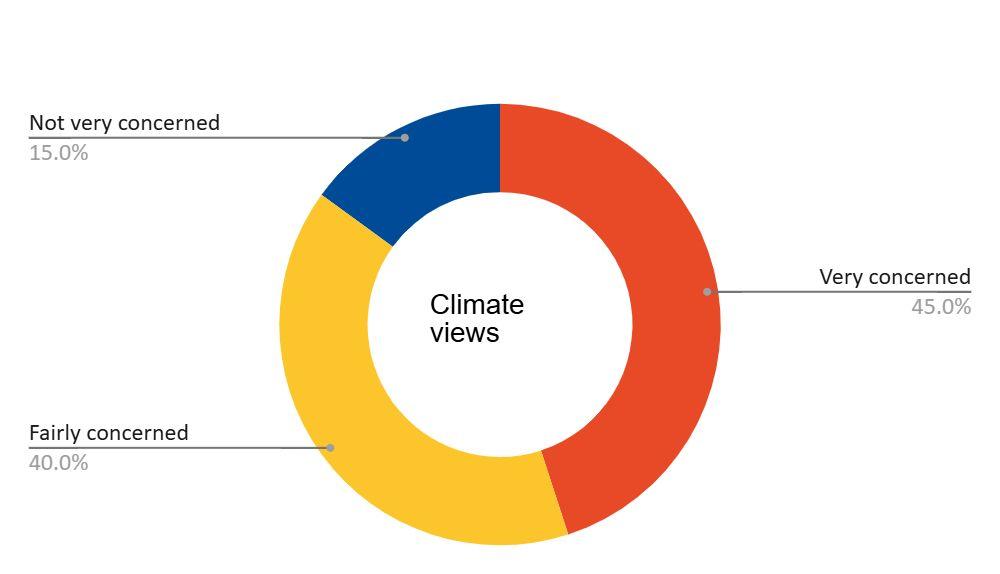

We agreed recruitment criteria with Wakefield Council to ensure the final group would be broadly reflective of local demographics (such as age, gender, ethnicity, location and housing tenure). We also asked people about their views on climate to ensure we got a range of climate perspectives in the room, not just those most interested in taking climate action.
Our Sortition process oversampled groups with small percentages (one person) to ensure that if that person dropped out (such as from illness) the group would still be included.
The tables opposite compare the population of Wakefield district (the target, from the 2021 census data) with the makeup of the final group of 20.
The recruitment of participants achieved a good spread of people across all criteria. Of the 20 members who attended the first session, 19 attended all three sessions. They were from a range
backgrounds, so the
was still reflective



20 participants took part, broadly reflective of the area across demographics
1 visionstatement
for a thriving, healthy, and greener district written in participants’ own words
6 speakers provided information and evidence about the topic.
10 projects deliberated on, agreed and written in participants’ own words
348 personhours of learning, conversations, deliberation and crafting projects and a vision statement


The vision captures what a thriving, healthy and greener district could look like in the future. It is grounded in the hopes, values and lived experiences of the members.
Members began shaping the vision in session one, exploring what ‘thriving’, ‘healthy’, and ‘greener’ meant to them. They drew inspiration from the visions createdbychildrenandyoungpeopleacrossthe district, as well as their own experiences.
In the final session, members revisited their ideas through a reflective ‘silent conversation’. A small group then crafted the final vision statement, bringing together the collective voice of the group.
To bring the vision to life, members co-developed a set of ten project ideas - each showing how residents, the council, businesses, and other local actors can work together to create change.
These ideas began in session two, where members heard from expert speakers on topics like systems thinking, climate co-benefits, waste and community-led action. Drawing on those insights and their own experiences, members created a long list of ‘ideas for action’ which they prioritised into top themes.
In session three, members turned these themes into detailed project proposals - explaining why each idea matters, who should be involved, and the impact it could have on Wakefield’s journey to net zero.

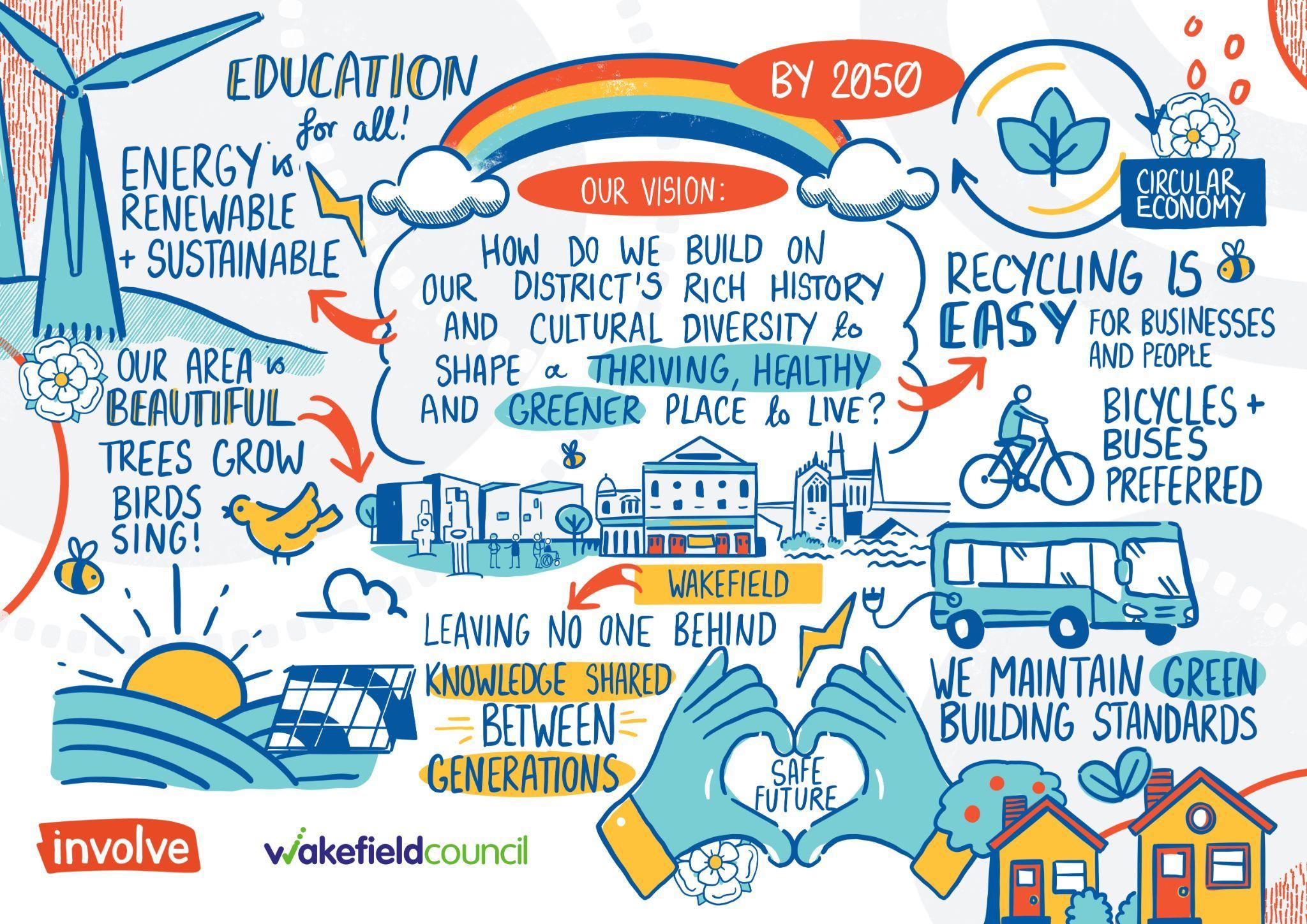


It is 2050. Recycling is easy, accessible and not the only option. All houses are ‘net zero’ via retrofit or green building standards.
Our rich heritage such as canals, riverside, Chantry Chapel and the area around the Hepworth Museum are cared for.
Environmental knowledge is shared and developed in schools as well as community hubs and outreach programmes, educating adults and the wider community. Knowledge of reduce and repair is shared intergenerationally.
Shops and businesses are incentivized to be ‘net zero’ and take part in community projects, promoting reuse, reduce, and recycle and food waste production.
We are free to access and roam green spaces across the district, where trees grow, birds sing, nationalised water runs and we feel good, using EV and sustainable transport to get us there.
Public transport is vastly improved, easily accessible and reliable. EV and cycle lanes are the preferred method of transport in urban and rural areas.
“In 2050 we have left a green, healthy and sustainable legacy forgenerationstocome”.

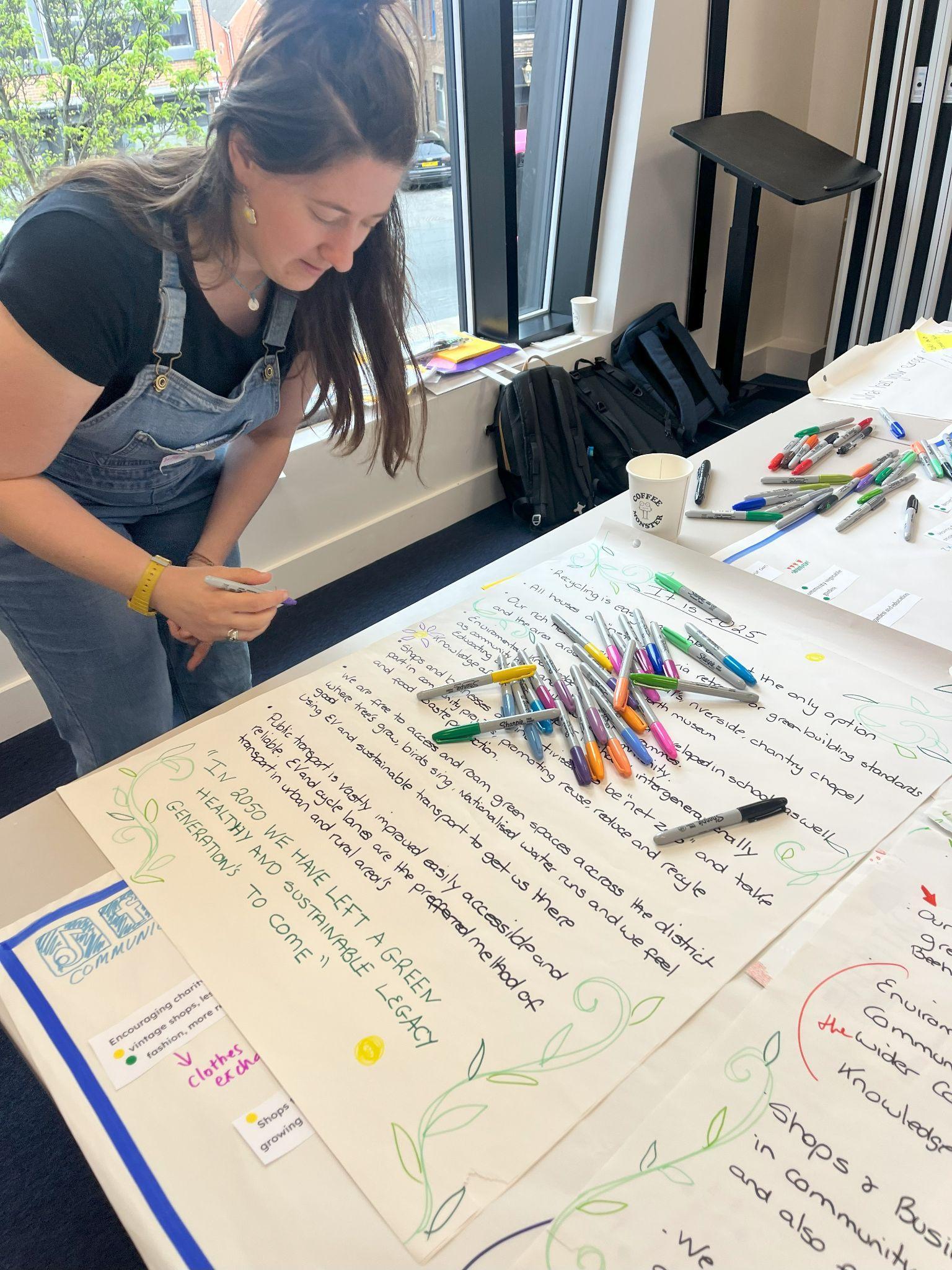

These ten projects reflect what people across the district want to see happen. They are a call to action - proposing new ideas and scaling up existing initiatives. Together, these projects offer a path to collective change: inviting residents, the council, businesses, and other local actors to work side-by-side towards a thriving, net zero district.

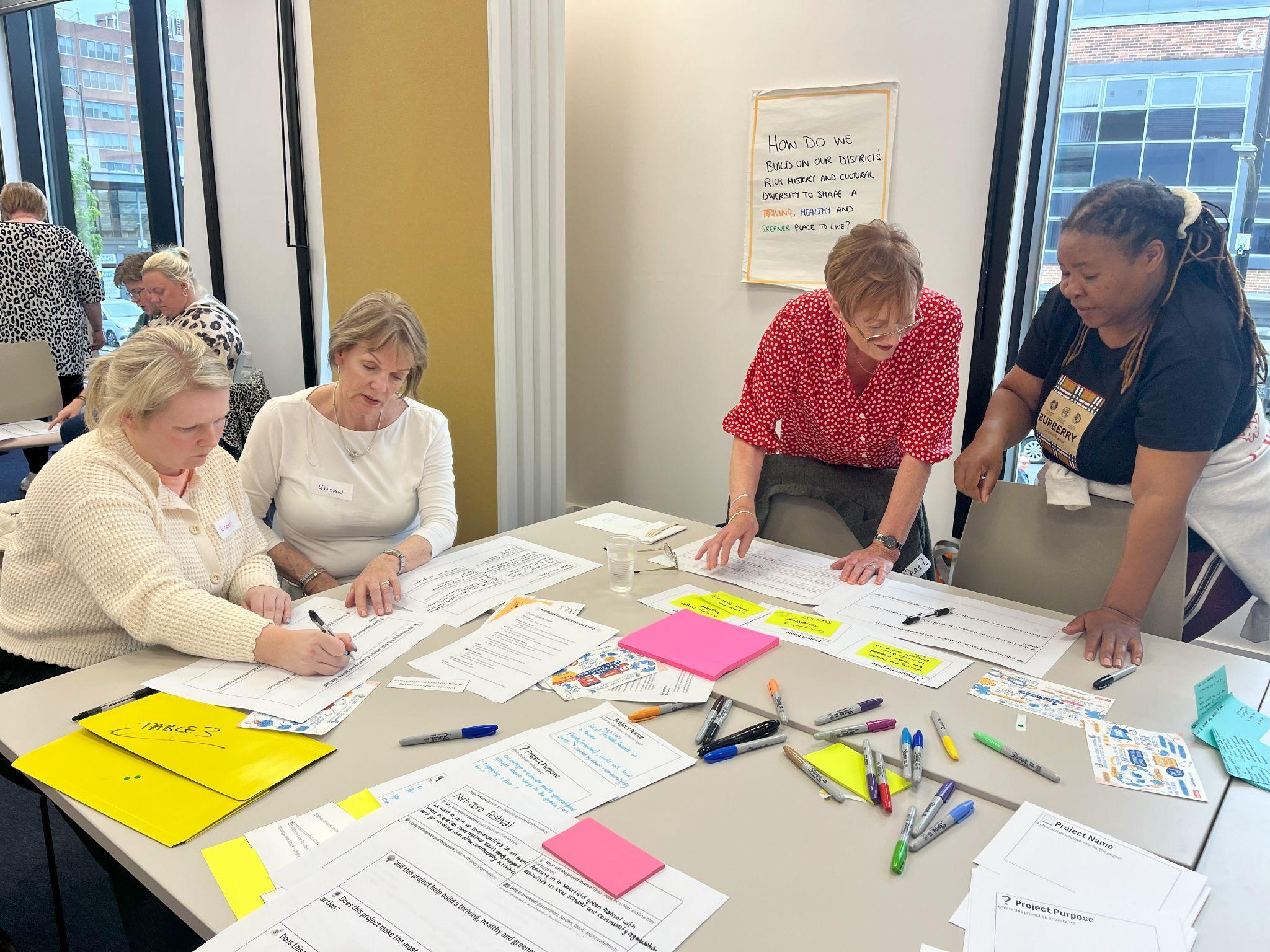
Note: Project numbers are for reference only and do not reflect priority or ranking
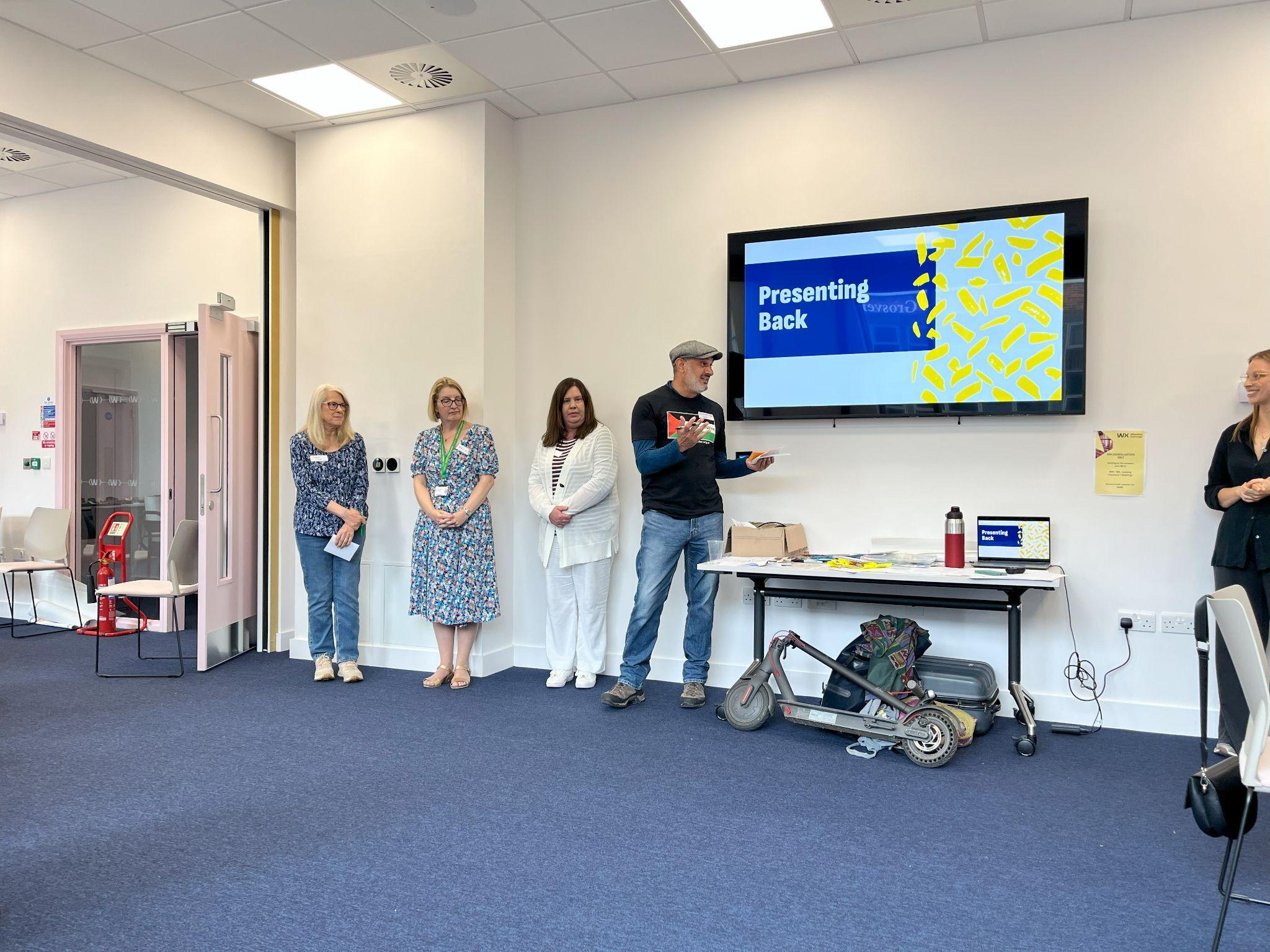
Project

WakefieldNetZeroFestival

CommunityEnvironmentToolkit








Whatitsabout
Adistrict-wideeventconnectingpeopleandshowcasinggreen initiatives
Adigitalhubtohelppeoplestartandsharecommunity-led environmentalprojects
AdvisorforFutureSustainableBuildingsatanAffordablePrice Supportandadviceforresidentsaboutenergy-efficient, affordablehomes
CommunityRenewableEnergy
UpliftingCommunities
GetConnected
FromSmallSeeds,StrongRootsGrow
Let’sBeeGreen
Ruralmini-buses
Usingunusedlandandwaterforwindandhydropower,reinvesting savingsintothecommunity
Rovingcommunitybusthatconnectsupcommunityhubsacross thedistricttouniteandsupportcommunity-ledgreeninitiatives
Cross-generationalcommunicationstobringtogetherallprojects andspreadawareness
Smallgardengrowingandfoodsharingscheme,ledbyolder residentstobuildcommunityconnectionandself-sufficiency
Socialmediaofficertopromotealllocalgreeneffortsand campaigns,especiallyforyoungerpeople
Communitybeekeeping,promotingbiodiversity,skillsandmental health
AccessibleEVminibuseslinkingruralareastotown,routes developedinconsultationwithresidentstoservecommunity needs
Mainoutcomes
Increasedawarenessandparticipationingreenactivities
Empowered,selfstartingcommunitiessharingbestpractices
Morepeoplehaveenergyefficientandsustainablehousingthat helpslowerenergybills
Cleanenergygenerationandreinvestmentincommunityprojects

Strongercommunities,increasedawarenessandengagementin greenactivities,improvedlocalgreenspaces
Greaterpublicengagementandunderstandingofnetzero progressandopportunitiesinthedistrict
Lowerfoodbills,bettermentalhealth,intergenerational knowledgeexchangeandstrongercommunities
Increaseddigitalengagementandenvironmentalawarenessfor youngerpeopleinthedistrict
Bee-friendlyspaces,skillsdevelopment,andlocalhoneysales
Greenertravelandbetterruralconnectivity

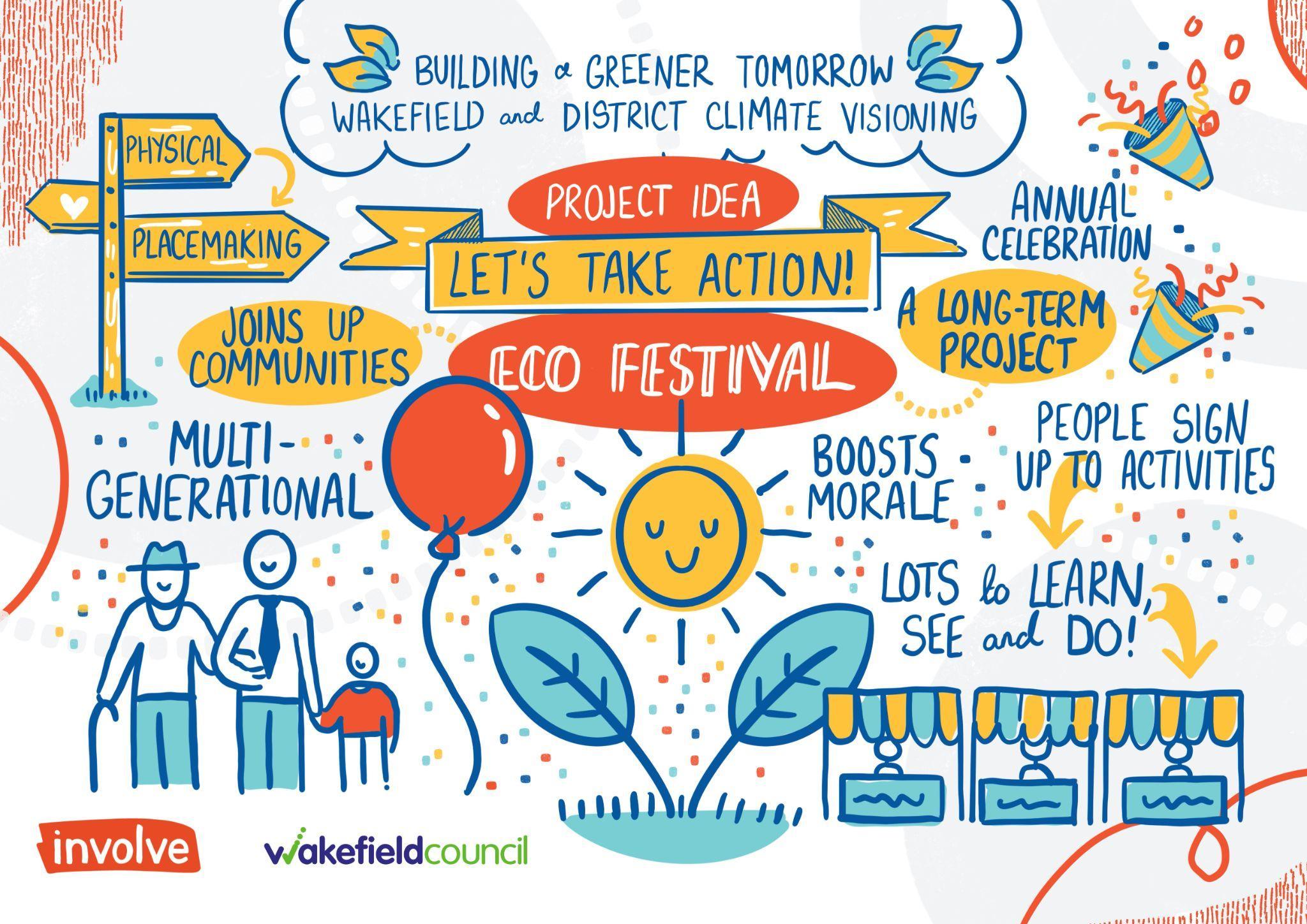


Whythisprojectmatters
Wewanttojoinupcommunitiesinaneventwherepeoplecancometogether, learn,supportandgetinvolvedwithothercommunityactivitiesaboutnet zero.

Expectedimpactsandoutcomes
Peopleareinformedofwhatishappeningacrossthedistrict;morepeoplesign uptogreenandcommunityactivities;andthegreennetworkoforganisations developedandstrengthened.

Measuringsuccess
Numberoforganisationsinvolved;outcomesfromworkshops;attendanceat eventsandactivitiesadvertised.

Whatwilltheprojectinvolve?
Smallactivitiesfeedingintoexistingfestivals,feedingintoaWakefieldGreen Festivalwithactivitiesinlocalschoolsandcommunityorganisationsshould bringtogetherotheractivitieslikesharingandcelebratingthecommunity toolkit.

Whoisinvolved?

Council,communityorganisations,businesses(forsponsorship),thisvenue [WakefieldExchange],volunteers,schools,everyone!

Communicatingabouttheproject
‘WakefieldNetZeroFestival.Wecometogethertolearnaboutandprotectour greenspaces’

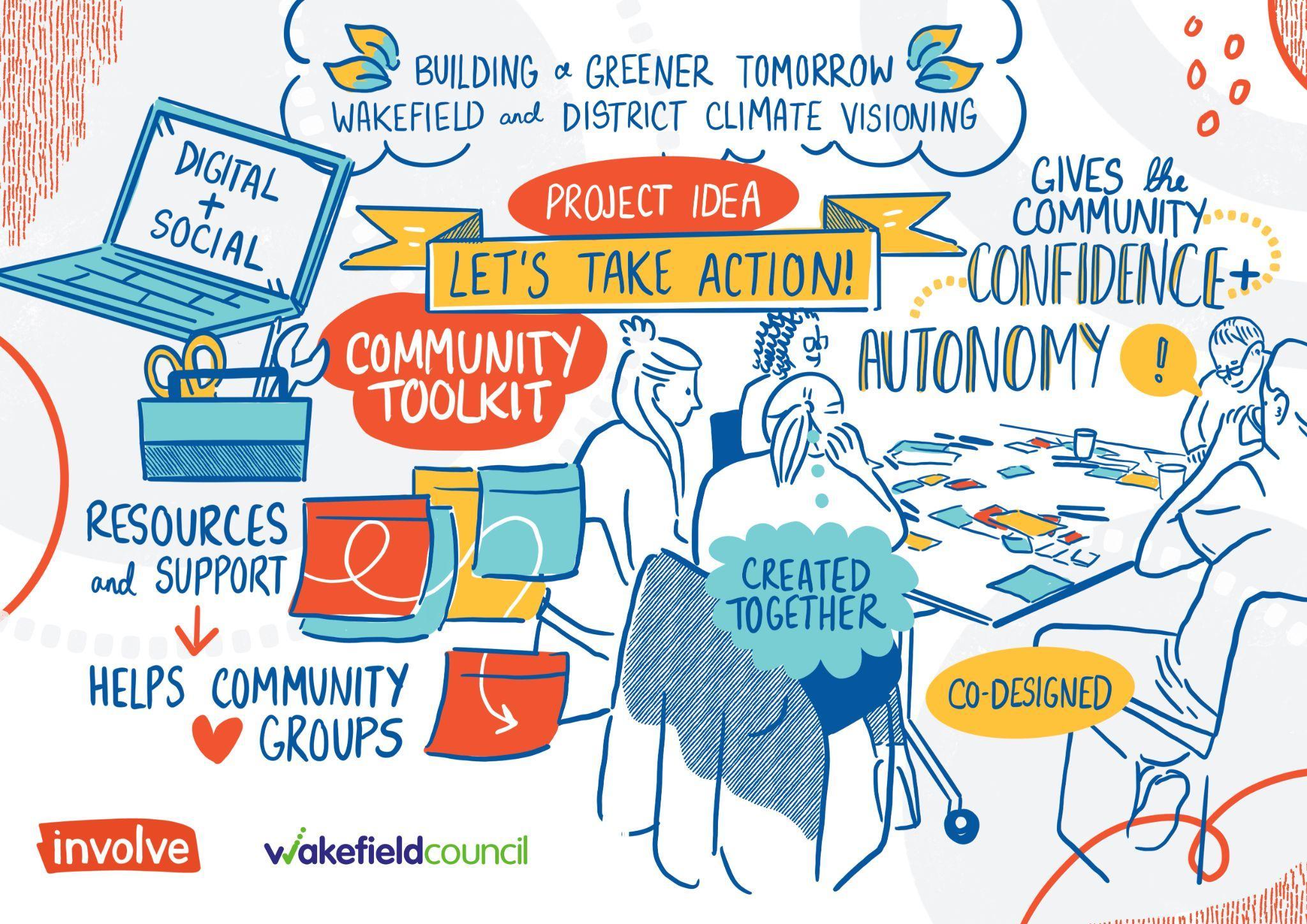


Encouragesindividualstotakeanactivepart,ratherthanexpectthecouncil todoeverything.Empowerspeopleto‘doitthemselves’(initiate).

Whatwilltheprojectinvolve?
ToolkitHubWebsite,withfacilitytohostindividualbranches’information andactivities.SharewithHubandbranch-to-branch.ThetoolkitHuboffers: contacts,information,step-by-stepguidesonhowtobegreenandset up/runcommunityorganisations.

Facilitatetheeasebywhichindividualsandcommunitiescanmotivate themselvestosetupandruncommunityledprojects,fortheirownbenefit. Sharingbestpracticebetweengroupsandbranches.

Bylookingatthehealth(posts)onthenetworks,branchesandengagement (visits)totheHub.Advisorsto‘visit’groupstoassess,monitorandadvise.


Thecouncil,volunteerbranchrep,moderator(onlinecontent),sponsors (localbusinesses,adverts),promotionthroughNetZeroFestivaland RoamingBus[otherprojectideasfromCitizenVisioningproject]

‘Makeyourideasapossibility’




Whythisprojectmatters
Enforcementneededtoimproveandcontrolenergyefficiencyinnew homes-adviceonimprovementstoefficiencyinolderproperties.

Whatwilltheprojectinvolve?
Buildingnewhousestospecificstandardsandimprovementinolder houseswherepossible;affordablehousingforfirst-timebuyers;quality checksregularly.

Expectedimpactsandoutcomes
Lessenergyusedtorunhomes-warmerinwinterandcoolerinsummercheaperbillsusinglessfossilfuelsormorerenewableenergysources

Whoisinvolved?

Councilplanningdepartment,builders,financialadviceorgovernment subsidiestomakeitaffordable.First-timebuyers.

Measuringsuccess
Eachdistrictwillachievenoticeabledropsinelectricityandgasusageand moreefficienthomes(EPC)withinthecomingyears,sustainabletools suchasheatpumpswillreduceinprice.

Communicatingabouttheproject
Supportandadvicecreatingsustainableandaffordablebuildingsfrom councilplanners,tomeetnetzerotargets.

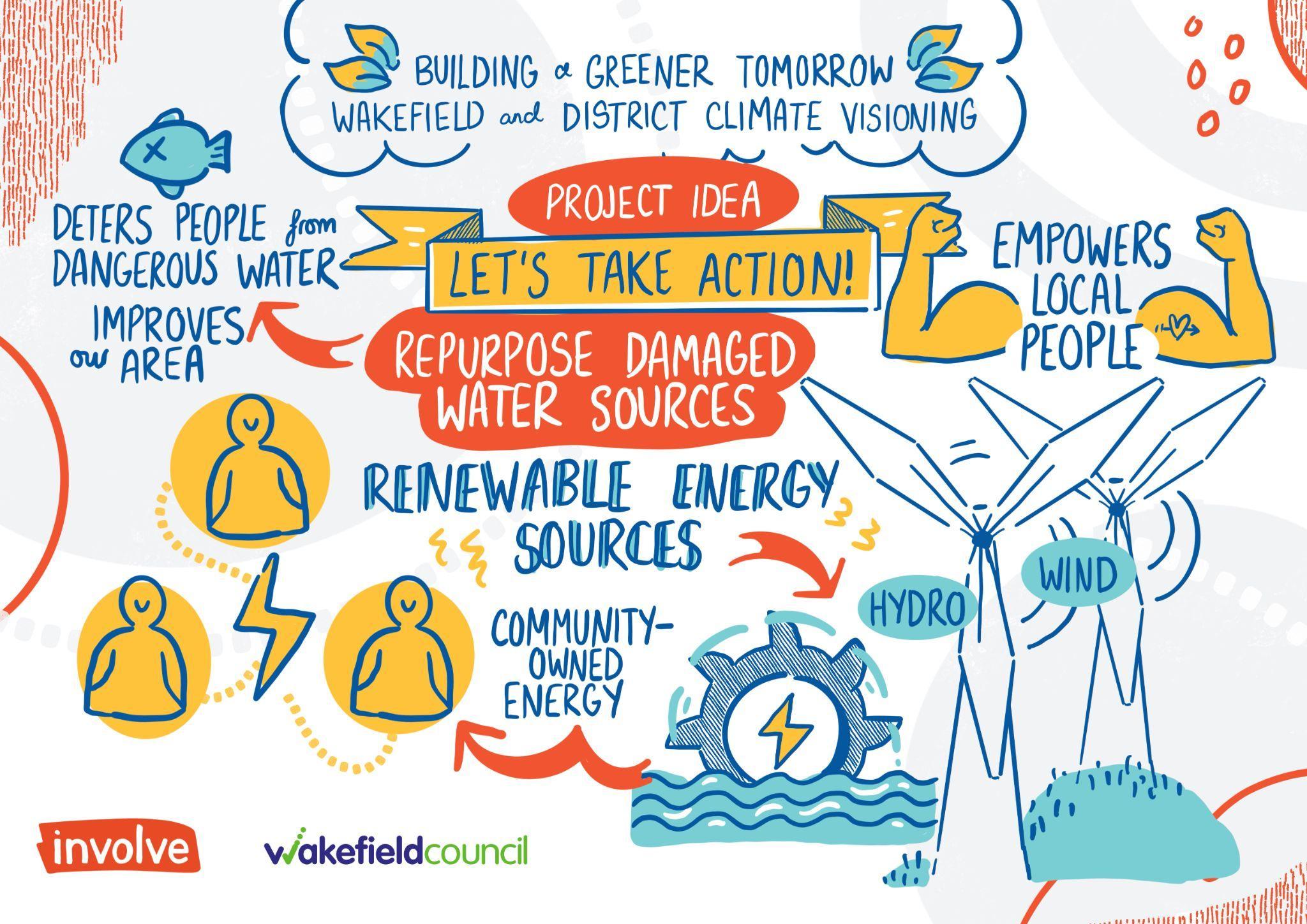


Whythisprojectmatters
Reducestheneedfornon-renewableenergysourcesandrepurposes watersourcesthatcan’thouseecosystems.

Whatwilltheprojectinvolve?
Unusedlandcanbeusedforwindturbinesandhydropower.Expertsin hydropower/windturbines/fundingforequipment.

Expectedimpactsandoutcomes
Useun-usedordamagedwatersourcesassitesforrenewableenergye.g. hydro,windturbines;moneysavedreinvestedincommunityprojects.

Whoisinvolved?

Landownersprovideland.Jointfundingwiththecouncil.Supportedby localcommunitymembers.Peoplefromotherareaswherethishasbeen successfullyimplemented.

MeasuringSuccess
Reducedenergycosts;reducedpollution;repurposingunusedwaterand land;improvedcommunityengagement.

Communicatingabouttheproject
Providingcheap,green,‘feel-good’energyforlocalneeds.




Whythisprojectmatters
Greatercommunityengagement,positiveenvironmentalimpact

Whatwilltheprojectinvolve?
Multileveleducationofallages,integratingdifferentcommunitygroups, createacentralhubinWakefield,buyandsetuprovingbustoengage ruralcommunities,counciltoorganise/promotelocalinitiative (communityclearup, wildspacemanagement,communityallotments)

Expectedimpactsandoutcomes
Strongercommunityspirit,improvedphysicalandmentalhealth, maintainedandimprovedgreenspaces

Measuringsuccess
Communityengagementsurveys,footfall,communitygroup membership.

Whoisinvolved?

Initiativesrunbycommunitygroupse.g.clothesexchange,barteringetc. Fundingandorganisation(toolkit)fromcouncil(levellingup)sponsorship localbusinesses.RepresentationfromMPsandcouncillors.

Communicatingabouttheproject
‘Creatingagreener,healthierWakefield,together!’

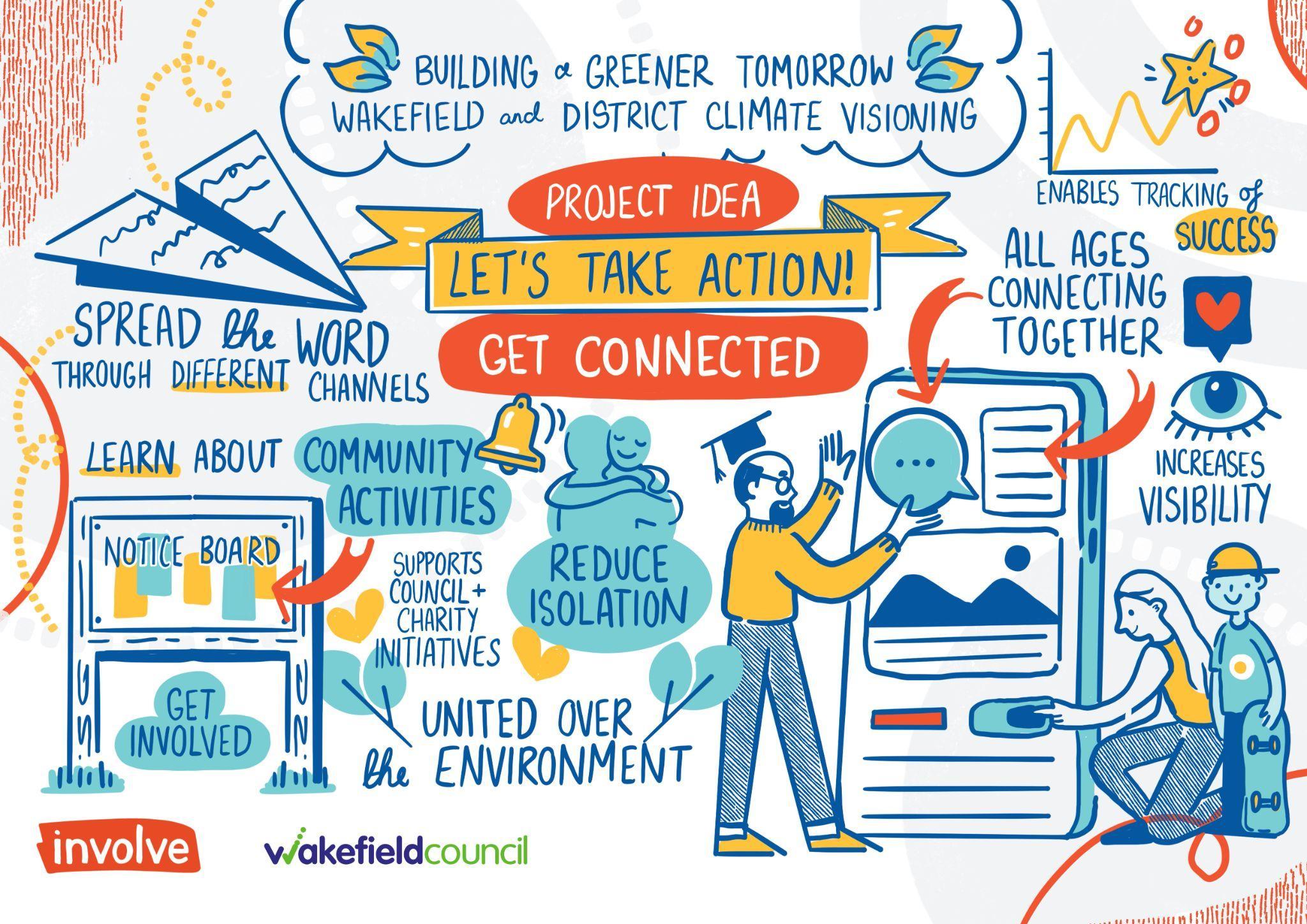


It'stoeducateeverygeneration,spreadawareness;targeteveryaudience;increaseonlinepresence fromthecouncilaboutnetzero,climatechangeandlocalefforts;showpeoplehowtogetinvolvedand whatactivitiesandeventsaretakingplace;itisthegluebetweenalltheprojects(socialmedia, awareness)

Younger:schoolsandeducationsystems;localnetzeroteams;localvolunteerstoprovidegroups andactivities.Middle:socialmediateamorleaderwhorunacampaignonmultipleplatformsused wilderbyyoungeradultsandolderadults;postandspreadawarenessforlocalinitiatives,eventsand projects.Older:newspaperarticles;telephonecalls;informationbooklet(every3monthsorso?)or eventscalendarpostedtooldergenerationsasopposedtosmallandoverlookedflyers;usealocal postalteamtosendouttheinfobooklet.

Allgenerationsaremoreconnected;allgenerationsaremoreaware;allarelessisolatedandwellbeing isincreased;increasedparticipationingreenactivitiesacrossthedistrict;educationincreasesingreen net-zerochallengesandsolutions;socialmediapresenceincreased;localinitiatives,societalprojects andcharitiesaresupported;waytoadvertiseeventsandWakefieldCouncilprojectsanddecisions;it shouldlinkeveryotherprojecttogether.

Younger:askkidstodrawpicturesorwritestoriesafterlessonsor clubstoseehowtheir understandinghaschanged.Middle:socialmediapollsorquestionnaires,followersandnumbersof peopleatevents,creatingsocialmediapagestogainafollowing,thisshowshowthelocalcommunity feelsandtogetreviews.Older:telephonesurveys,paperquestionnaire(freepostage).All:visiblynotice achangewithinthelocalcommunitysuchas,moregreenprojectsandgroups(e..ggardeningclub), promotingeventsliketheEco-Fest,increaseinthenumberofpeopleattending;ourprojectlinkswill withthe@wakefieldnet0project,socouldcombinethesetomakeonebigproject.

Younger:teachers,parents,guardiansandlocalyouthgroups;Middle:Councilsocialmediamanager andteam,localcommunitymemberscanvolunteertotakepartinspreadingthecampaignontheir accounts.Older:Newspapercompanies,someonetowritethearticle,peopletomakephonecalls, localchurchgroupsorrespitecentres.


Bringallgenerationstogethertogetinvolvedinbuildingathriving,greenerandhealthierplaceto live.‘Bethechangeyouwanttosee’




Whythisprojectmatters
Education,mentalhealth,it’ssimpleandsustainable.

Whatwilltheprojectinvolve?
Residentsstartgrowingfoodinpotsandsmallergardenspaces.Volunteersrun sessionstoimproveknowledge-thesesessionsareledbyretiredpeople.
Communitiesapplyknowledgeintheirownareas.Volunteerscangetinvolved inhelpingpeopletodesigntheirsmallfoodgardens, forthosewhocan’tdoit themselves,needhelp,oraren’tinterestedindoingtheworkthemselves.

Cheaperhouseholdbillsforfood;peopleareself-sufficient;re-learninglost knowledge;buildingcommunityskills;fruitandvegetableexchange.

Whoisinvolved?

Counciltoprovideresourcese.g.pots,seeds;oldergenerationsteach gardeningknowledge;Communityappliestheknowledge;groupstocollect plantpotsandbringcommunitiestogether;workwithsmallbusinesses; sponsoredbygardencentres/supermarkets;cansellproducebacktoshops.

Sampleviewsofparticipants,ifthesegroupsincreaseortheamountofpeople takingpartincreases,thisisasignofsuccess.

Communicationwouldbespreadbywordofmouth,noticesinchurches,garden centresandothershops.Accessibilityisdeterminedonaperson-to-person basis.‘Learntosuccessfullygrowyourownfoodforfreeaswellasexerciseina socialenvironment’




Whythisprojectmatters
Engageyoungerpeople;creatinggoodhabits;butincluding‘all’tothink greener;communicationiskey.

Whatwilltheprojectinvolve?
Theprojectinvolves apersonorteamdedicatedtosocialmediai.e.TikTok, instagram,facebook,communitypages,promotingupcoming environmentaleventswithinthecommunities.Theproject:making‘all’ awareofourclimateandthechangesitneeds.

Expectedimpactsandoutcomes
Breakdownofgenerationalbarriers;bringingpeopletogether;allbecoming ‘agentsforchange’.

MeasuringSuccess
Surveys,polls,footfallatevents.


Whoisinvolved?
Socialmedia,localmedia,companies,communities,‘lionesses’,local councils,sponsors

Communicatingabouttheproject
‘Communicatingourgreenerideasdigitally’

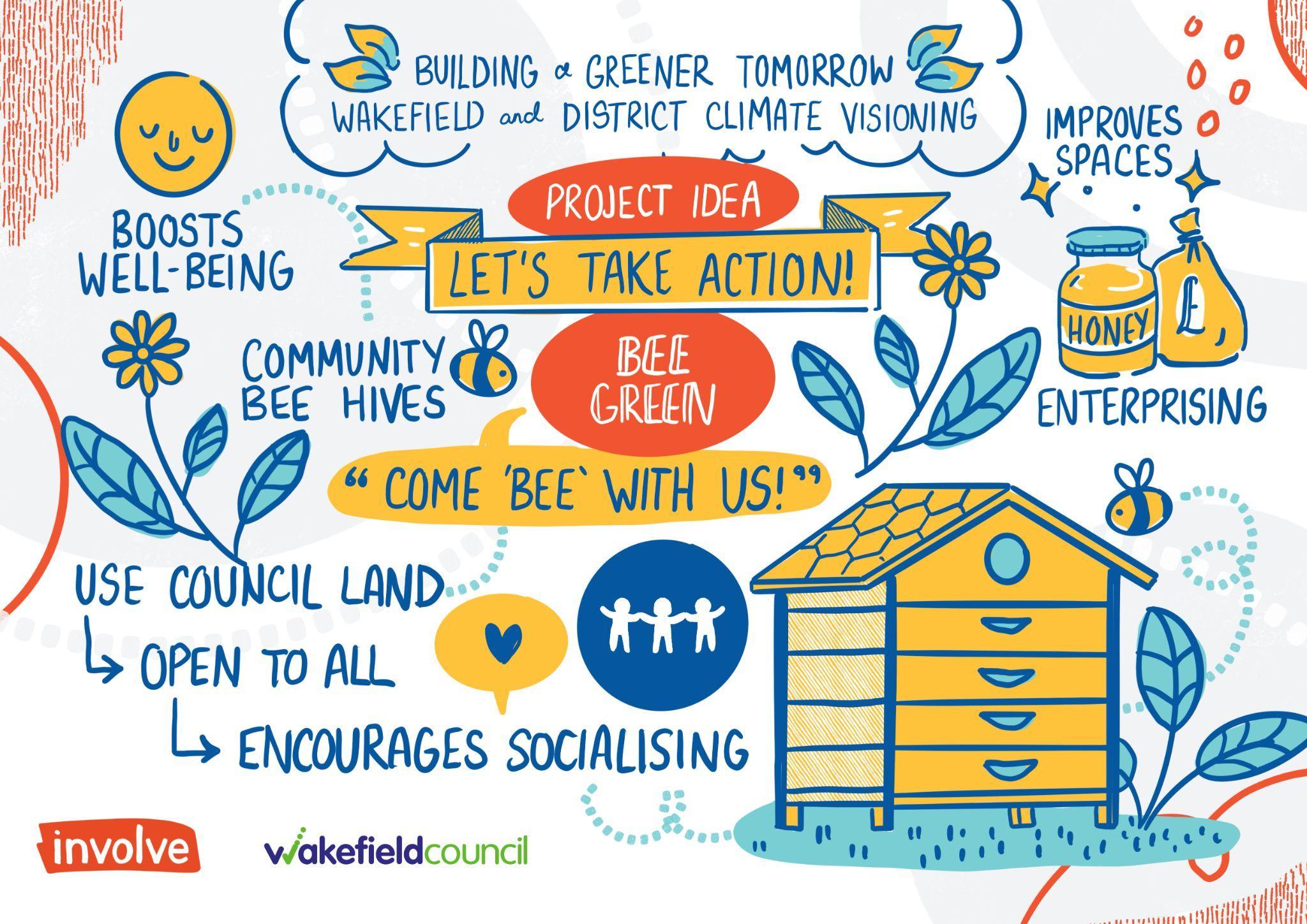


Whythisprojectmatters
Promotesmentalhealth;peoplebeingtogether,learningnewskills; appreciationofhowimportantbeesarefortheenvironmentandhelpingany fearsapersonmayhave.

Whatwilltheprojectinvolve?
Useofrepurposedcouncillandwhereagoodnumberofhivescanbeinstalled. Needstobewhererelaxedmovingandwildflowersareencouragedtogrow. Needtrainingtolookafterthehivesandprotectivesuitsetcneedproviding.

Expectedimpactsandoutcomes
Localcommunitieswouldbenefitandwouldbegoodforpeoplewhoarenot workinge.g.jobcreation.Thehoneycouldbesoldontohealthfoodshopsand farmersmarkets.

Measuringsuccess


Whoisinvolved?
Businesspartnerseg.gardencentres,plantnurseriesandsuppliers.Alsoneed hardwaresponsorsforthesupplyofwoodforfences.Alsogoodtohave schoolsinvolvedfortheireducation.

Communitiescouldthrive-itgivespurpose,helpsmentalhealthissues. Communicatingabouttheproject ‘Comebeewithus!’

Whythisprojectmatters
UsingEVminibusesinruralareaswillreducethenumberofcarsontheroad therebyreducingairpollution.Mini-busescancontributetothemorefrequent runsofbuses.Itwouldhelpruralpeoplecomeintotownandinteractwith urbanpeople.

Expectedimpactsandoutcomes
Alongsidehelpingpeopletraveleasilyintotown,thiswouldbeenvironmentally cleanerandgreenerandcouldincreasepeople’sopportunitiestoaccess employment.

Measuringsuccess
Evaluation:numberofbususers,measurementofairpollutionand expenditure.

Whatwilltheprojectinvolve?
PurchaseofnewEVmini-buseswhichareaccessibletowheelchairusers.
Consultationbetweenbuscompaniesandthepublictoascertainthe necessaryfrequency,timingsandroutes.Note:asimilarschemetothisis neededinnot-ruralbutnot-centralpartsofWakefield.

Whoisinvolved?

Council,buscompany,sponsorsandadvertisers.Residentsandbususers.

Communicatingabouttheproject
‘Travelbybus,gogreen!’
Feedback from the three citizen visioning workshops reveals consistently strong engagement, trust and enthusiasm among participants. Throughout the sessions, attendees gained a clearer understanding of the process, grew more confident in sharing their ideas and showed a strong desire to stay involved.
At least 85% of participants in each session felt they understood the day’s purpose, were able to contribute meaningfully, and learned something newhighlighting the accessibility and inclusiveness of the workshop design (see details in appendix 2).
Qualitative insights further emphasised respect, inclusivity, local pride, environmental commitment and the need for transparency and clear communication (see next slide).
Together, the data suggests that across the three sessions the group moved from curiosity and hope to purposeful participation and readiness for the next stage of collaboration.

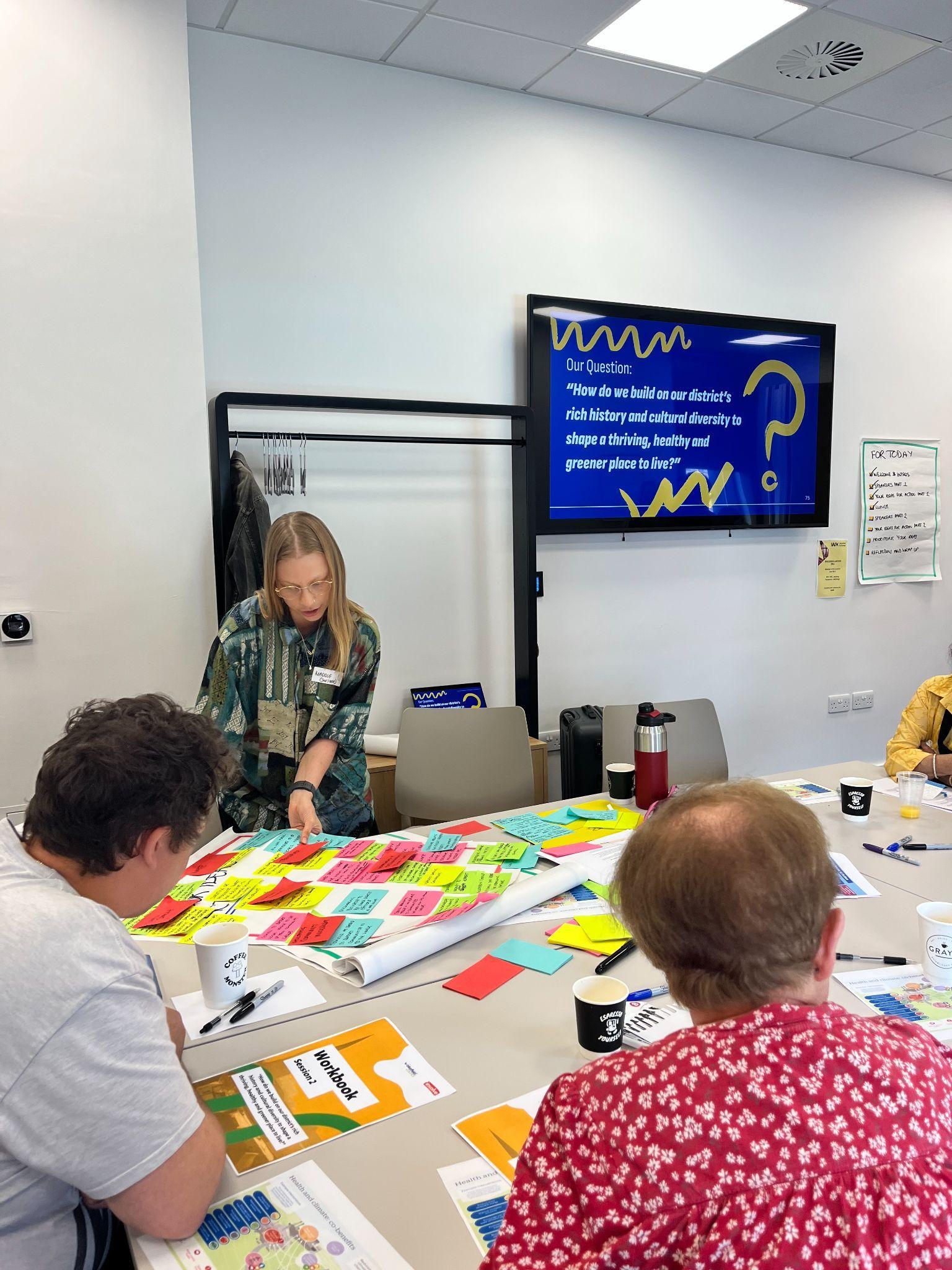
TThe session gave me a clearer idea of what this project is trying to do. I wasn’t sure at first, but now it’s clicking.
RReally appreciated the respectful atmosphere. I felt able to say things I wouldn’t usually share.
I came away with things I can act on at home and in my neighbourhood.
I want to keep being involved – it’s becoming real now. I

We brought the Advisory Group together in July 2025 to reflect on the final vision and project ideas. Their discussions surfaced these key themes.
● Persistentpriorities. Housing and transport were strong themes in the projects ideas - even without dedicated speakers on these topics - showing their importance to residents.
● Intergenerationalappeal. People want to see projects that bring generations together.
● Communicationgaps. We need more resident-focused, story-led communication to connect people to projects across the district. The current approach isn’t working.
● Simplifydelivery. Many ideas are practical and achievable. Let’s stop overcomplicating and instead ask - why can’t we do this?
● Quickwinsandbigchange. Some projects can start now; others support longer-term social change. Both matter.
● Advocacytools. Some ideas lie outside council control but can help us advocate for wider policy change.
● Powerofpartnerships. Working with businesses, communities, and regional networks could unlock impact and funding.
● Strategicfit. The projects align well with the District Plan and will shape the new Climate Change Strategy.
● Deepengagementworks. Listening, learning and building trust with residents adds real value.
● Amodelforthefuture. This citizen visioning approach should shape future engagement across the district
● Transparencybuildstrust. Share progress honestly, even when plans change or can’t be delivered. This strengthens relationships and maintains council accountability.

In May and June, we met with three schools across the district to hear their vision for the future of the district. Each school followed a version of this plan.
Lesson Plan 120 mins
Time Activity

5mins Introductions to delivery team, lesson purpose and what will happen with their ideas
15mins Appreciative inquiry. What do you love about your local area? Prompts to think about: where they live, how they get around, where they spend their free time, what makes them feel happy and healthy, how people earn money, where people do their shopping, where they learn, how they feel connected to each other
25min Co-benefits of climate action. Bingo game introducing co-benefits of taking climate action. Co-benefits include: protecting nature, creating jobs and skills for the future, reducing pollution, building strong communities, improving physical and mental health, promoting a fairer society, improving comfort in homes, easing costs of living pressures, making travel easier, safe spaces to hand out in a climate changing world
15min Considering the question. Introduce the question and provide supporting examples of local climate action in the UK.
15min Break
40min Poster creation. Posters created in response to this prompt: It’s the year 2050, and Wakefield has done a great job at tackling climate change. Imagine you’re walking around your area - what do you see, hear and feel? What’s different? What makes it a great place to live?
5min Sharing back. Volunteers share their poster with others
10min Quiet reflection. Short reflection sheet exploring how they found the session
5min What happens next. Explanation of where their ideas will go and how we will close the loop
Young people were clear: they care deeply about the future of their communities and the planet. They want to be involved, heard, and respected as equal partners in shaping a greener, fairer future.
Act fast and act together.
● “Change needs to be made quicker”
● “If we work together, we could make the environment healthier and better to live”

Involve young people directly.
● “Invite young people to workshops”
● “Do more things together [across generations], like tree planting and litter picking”
Every voice matters.
● “No matter your likes, dislikes, race, disability, everyone is equal and everyone can help make an impact”
Young people want a seat at the table.
● “We are actually a fresh set of eyes which can help mould and inspire others”
● “Many young people do want to help or share ideas”
Model positive behaviour.
● “Set a better example for children and let them know what’s right or wrong to help us in the future”
Respect and value young people’s ideas.
● “Don’t dismiss us”
● “Use our ideas as inspiration”
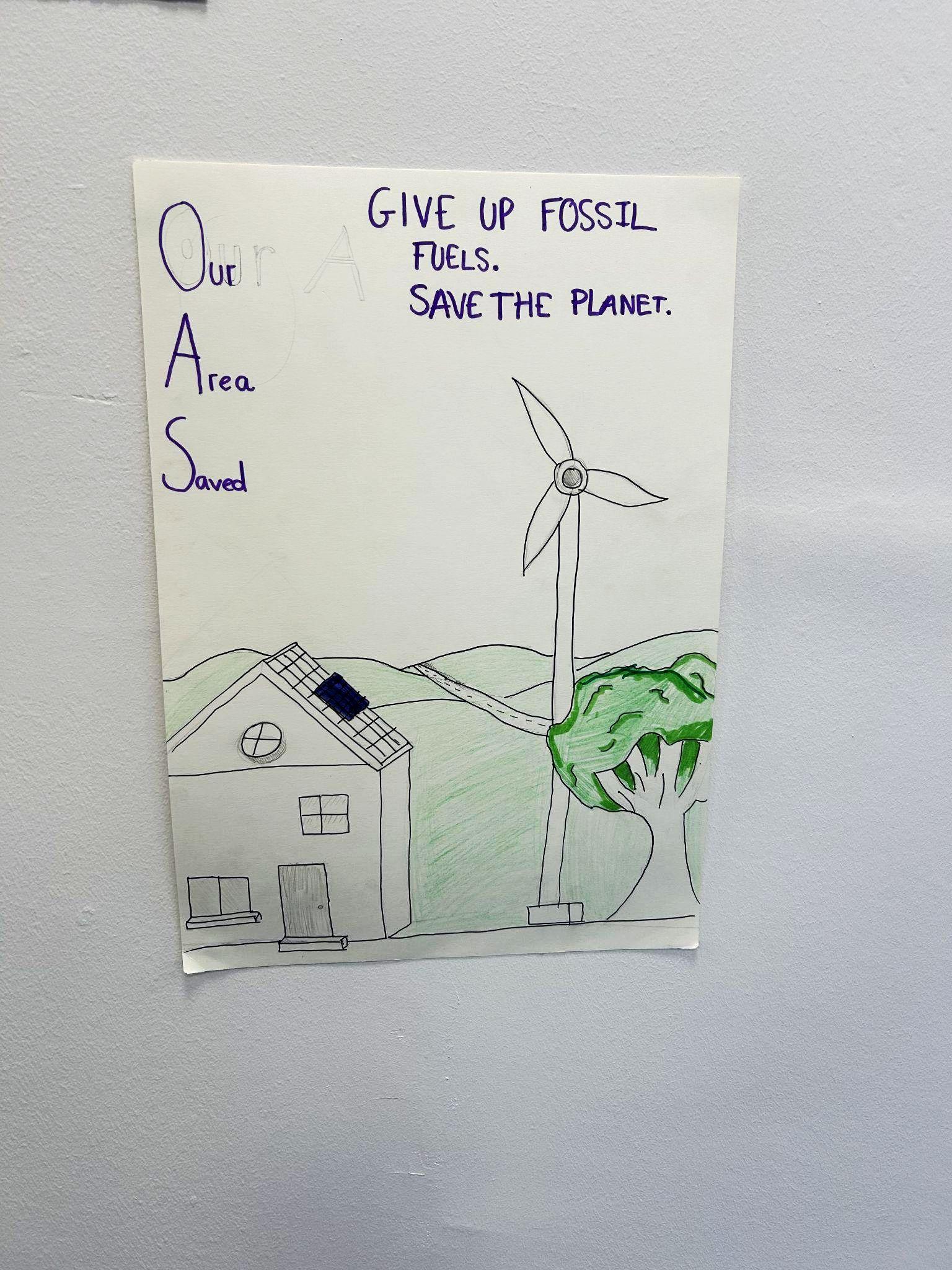

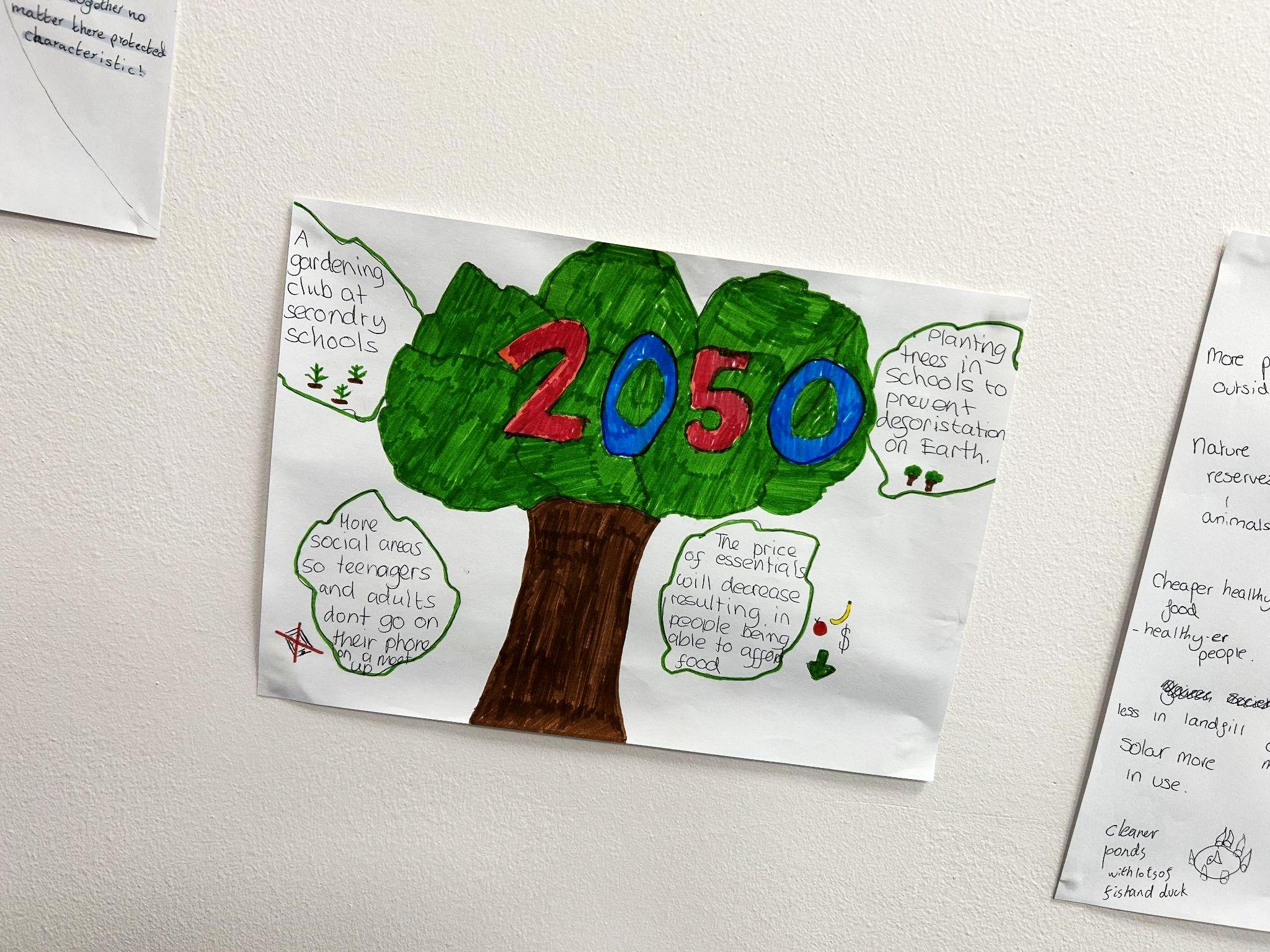
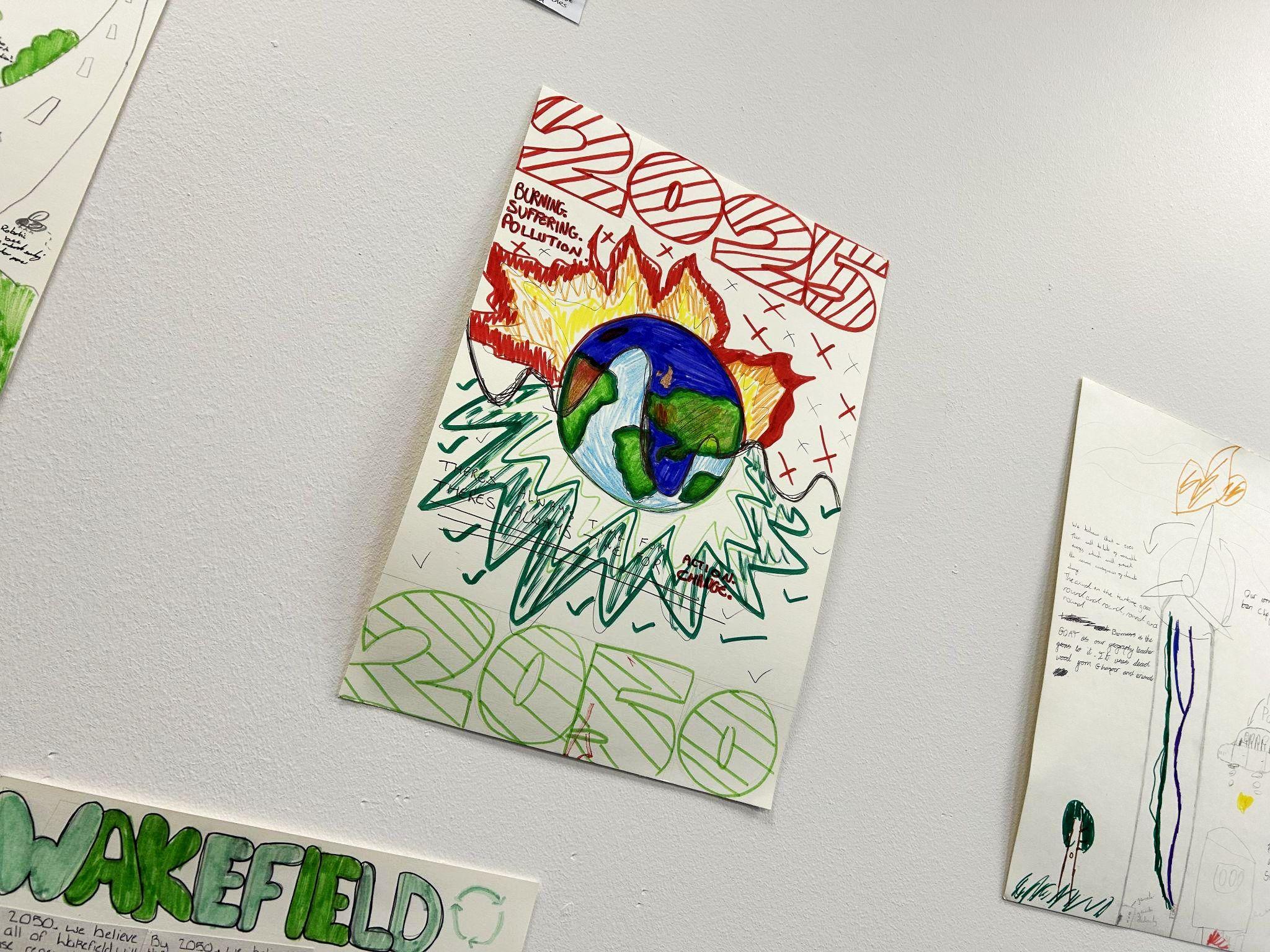

At the end of each session, members were asked to complete a short feedback survey about their experiences of the session. We’ve summarised the quantitative data from the three surveys in this table.

A week after the final Citizen Visioning session, key actors from across the district met to network and share learning on the transition to net zero. We ran two 45min workshops sharing the results of the Citizen Visioning project and gathering ideas for how to turn the projects into action.
A total of 11 actors attended the workshops. They included councillors, council officers, business owners, community leaders, and environmental organisations. This was a good opportunity to socialise the citizen visioning process and outcomes with a wider audience of actors across the district.
We were lucky to be joined by one of the citizen visioning members, who shared their experience of what it was like to take part in the process.
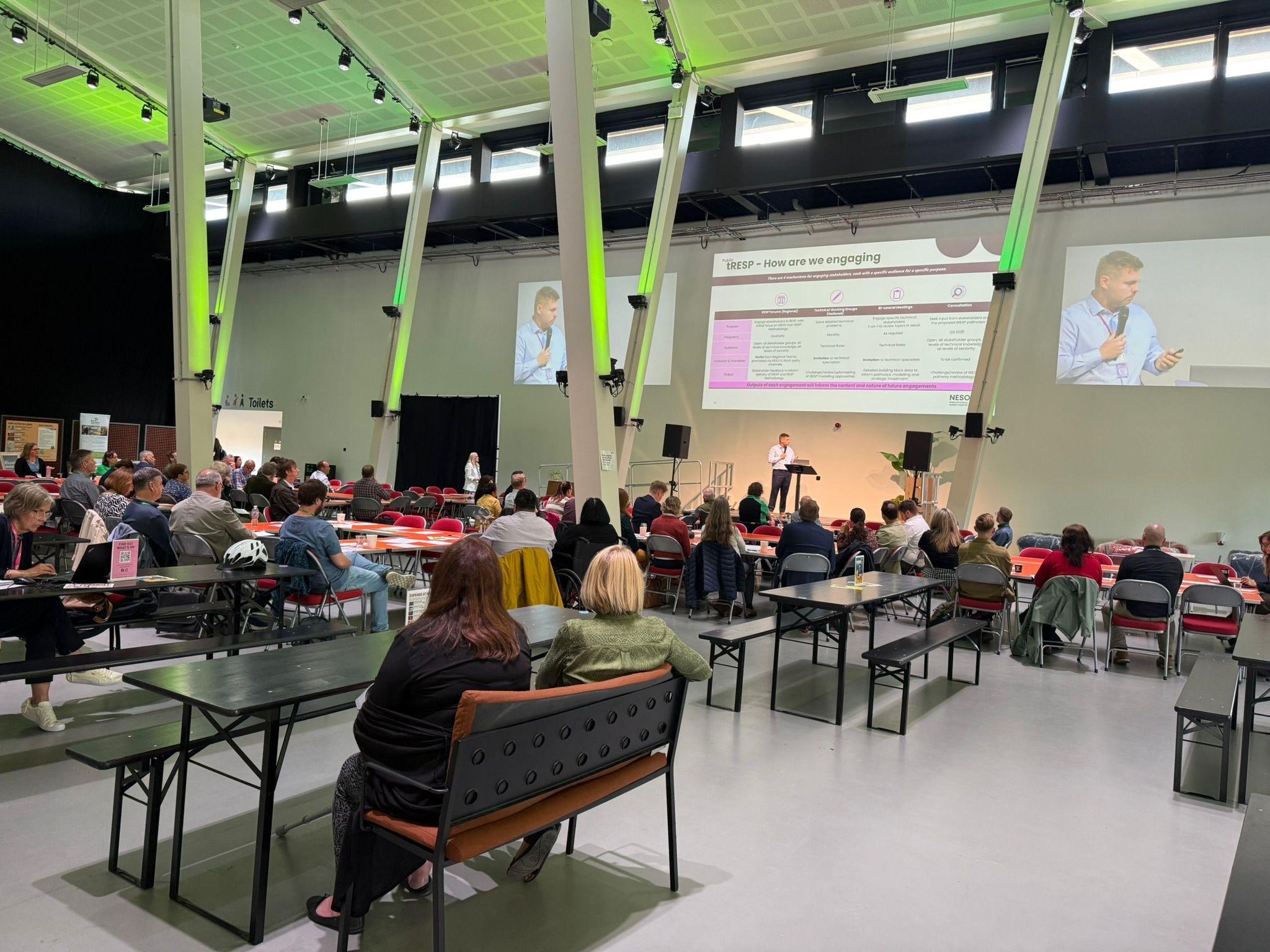

The Advisory Group played a pivotal role in the project’s success. They contributed insights, local expertise, and content to ensure the evidence presented was balanced and the outcomes make a meaningful impact to the local policy landscape.
The Advisory Group brought together key actors from within and outside the council:
● Wakefield Council Teams: Climate Change, Street Scene, Communities, Public Health, and Planning, Transport and Highways
● NHS
● New College
● Robertsons
● VICO Homes
Over the course of the citizen visioning project, the Advisory Group we convened the Advisory Group three times. Each meeting focused on key aspects of shaping and refining the process.
● Meeting One. We introduced the citizen visioning project, explored evidence selection and outlined what makes an effective recommendation
● Meeting Two. We defined what success would look like, review the feedback on the draft vision and ‘ideas for action’, and explored ways to maximise impact
● Meeting Three. We shared the final vision statement and project ideas, and discussed how to turn the ideas into action.
Through their expertise and collaboration, the Advisory Group ensured the project delivered a compelling vision and actionable projects that reflect the needs and aspirations of the community.

This project was funded by Innovate UK as part of the Net Zero Living programme which aims to help regional authorities accelerate the transition to net zero.
Involve, Forum for the Future, Ipsos and Quantum Strategy & Technology were appointed to support 25 ‘Fast Follower’ local authorities with their work on visioning and citizen engagement.

Around a third of the UK’s carbon emissions are dependent on sectors that are directly shaped or influenced by local authority practice, policy or partnerships. Many of the technological solutions needed to move places to net zero already exist, but local authorities face many challenges and barriers when trying to deliver these solutions at the scale needed.
The cohort of 52 funded places across the UK are delivering projects to overcome the non technological barriers to delivering net zero in a place.

